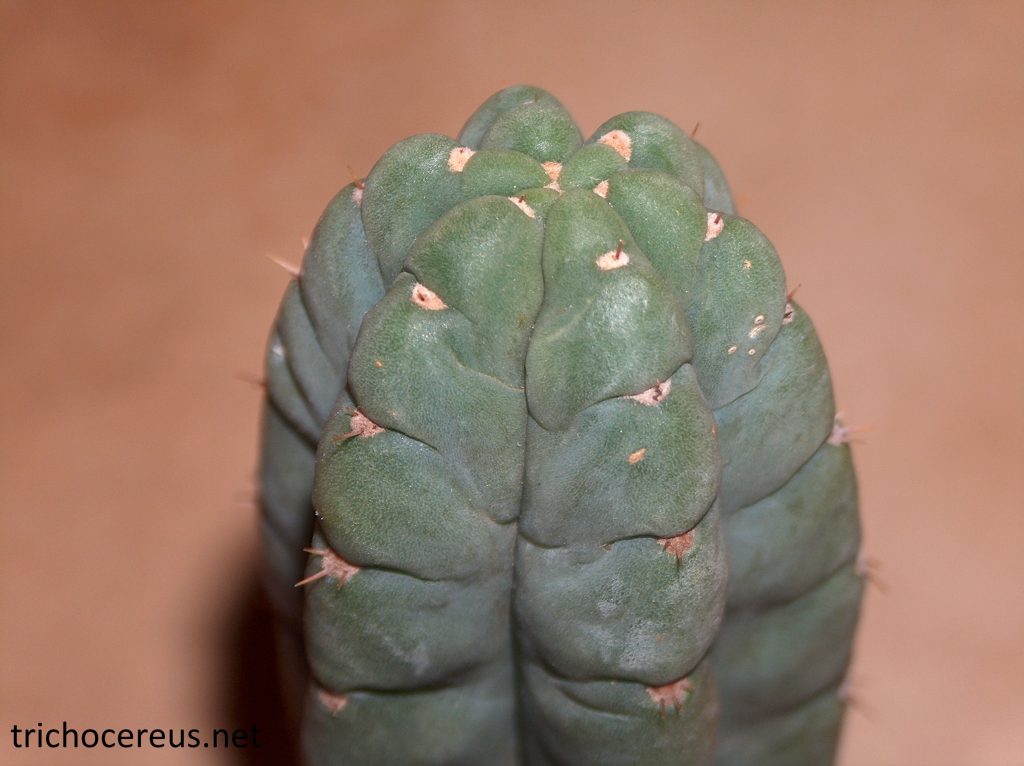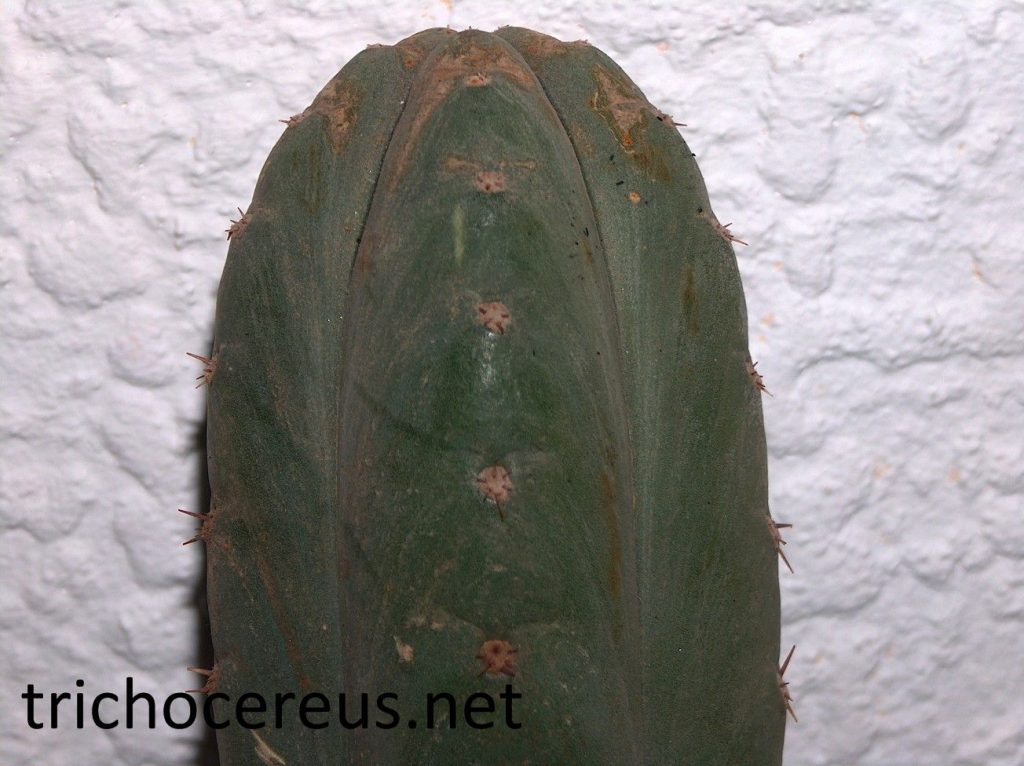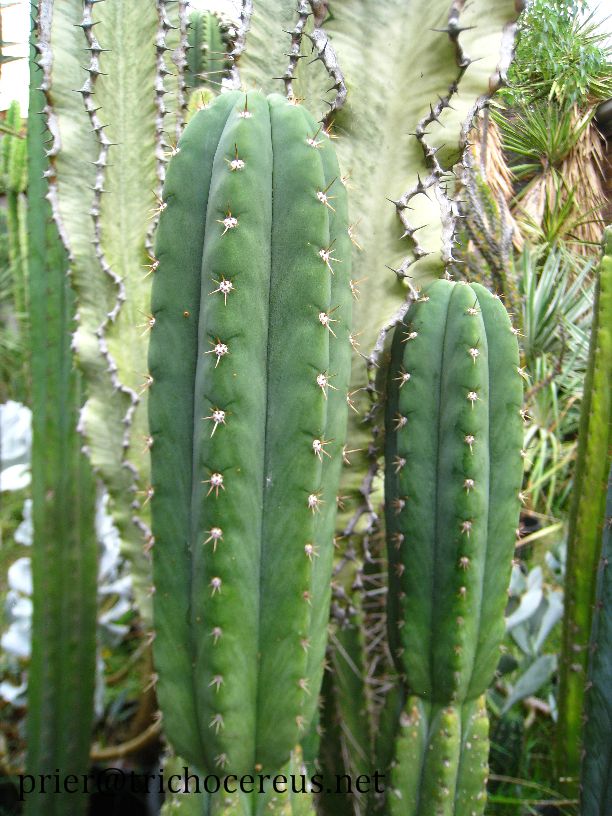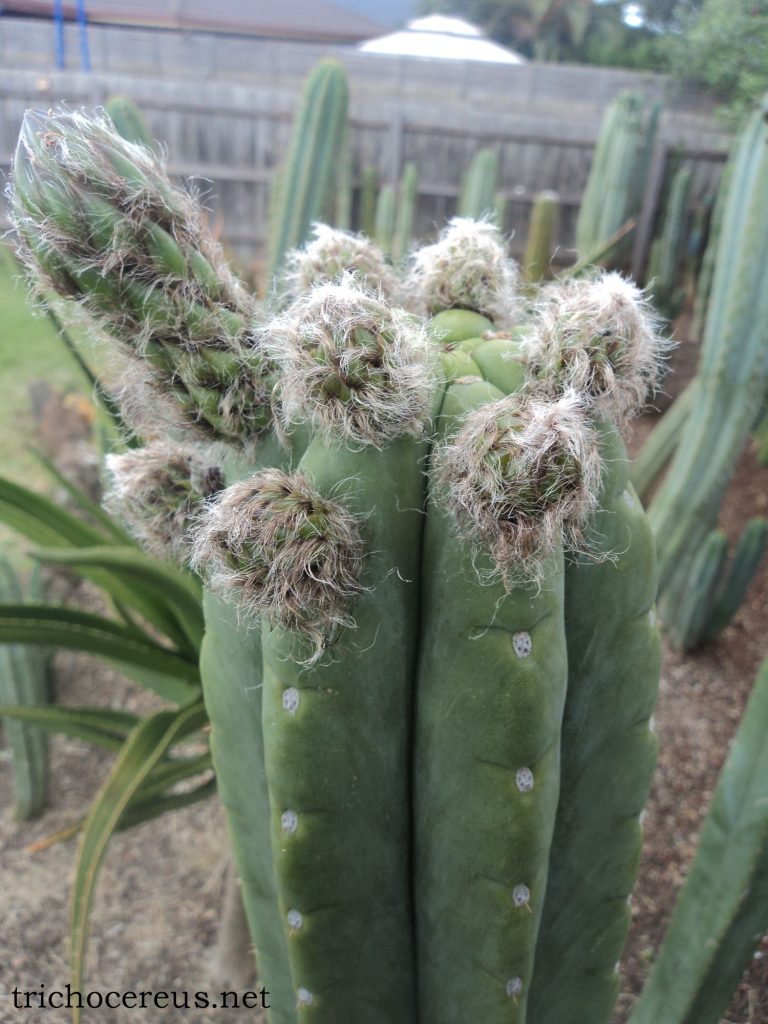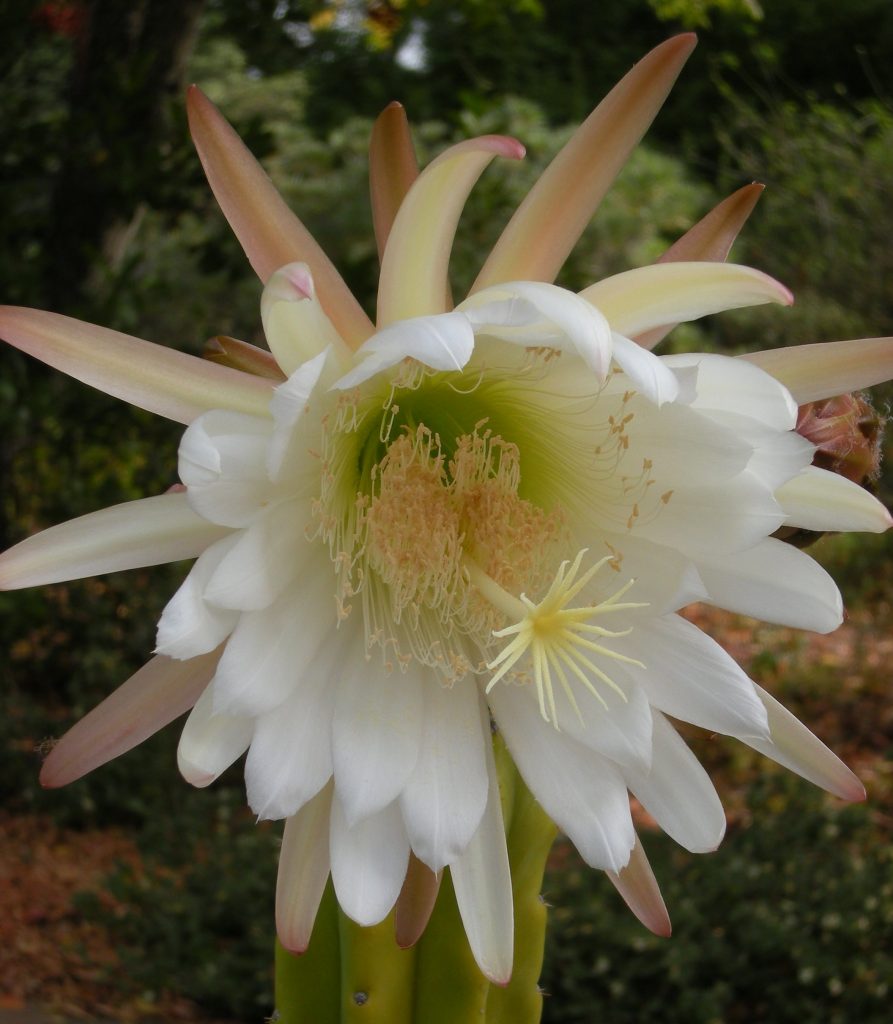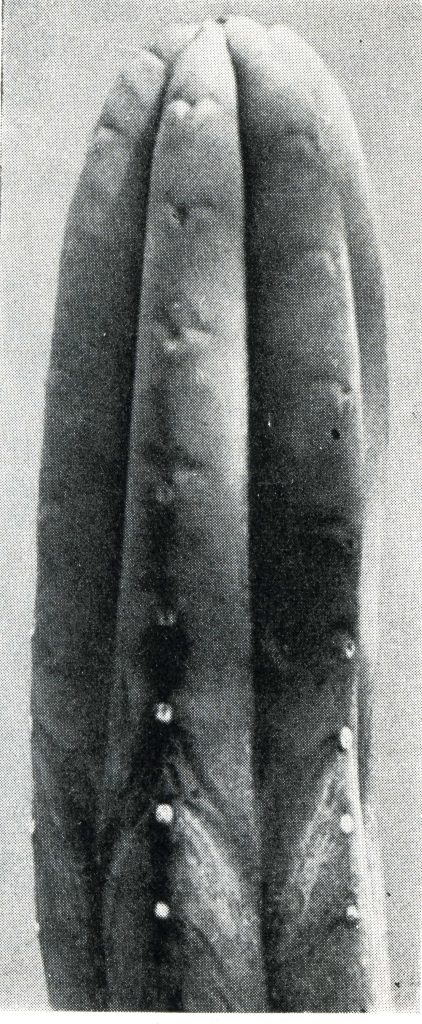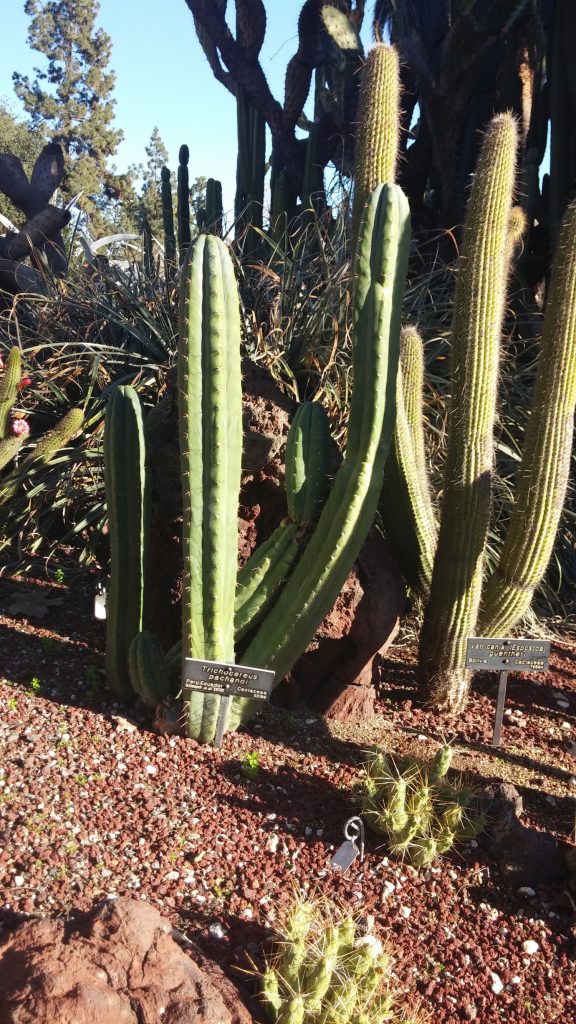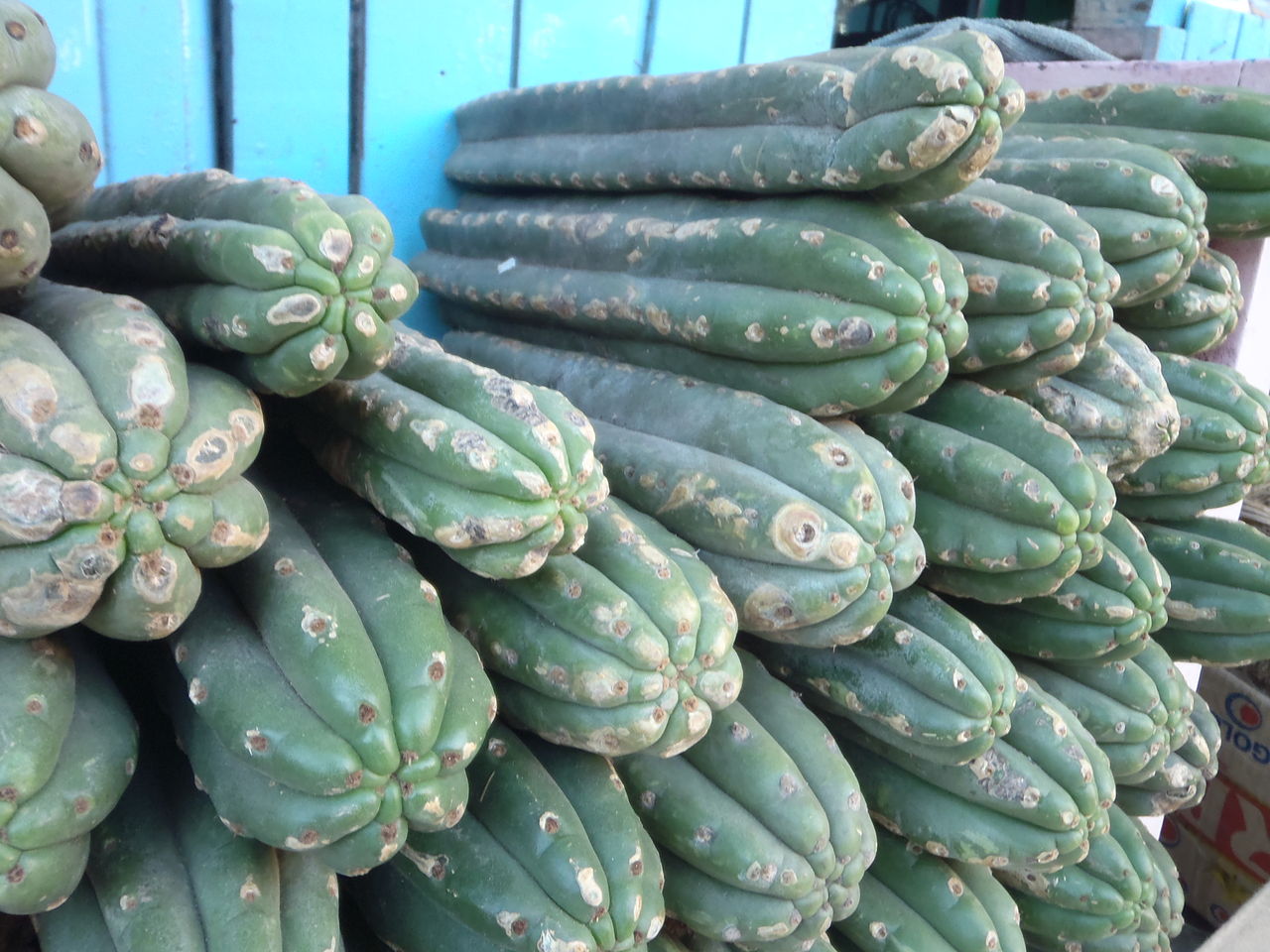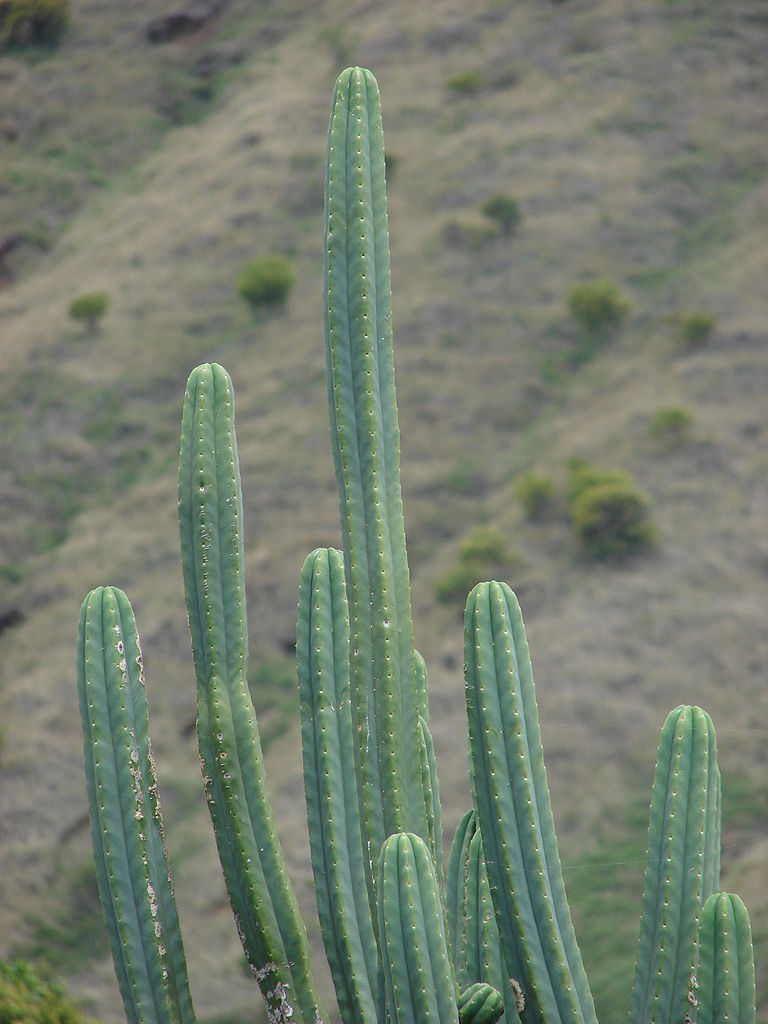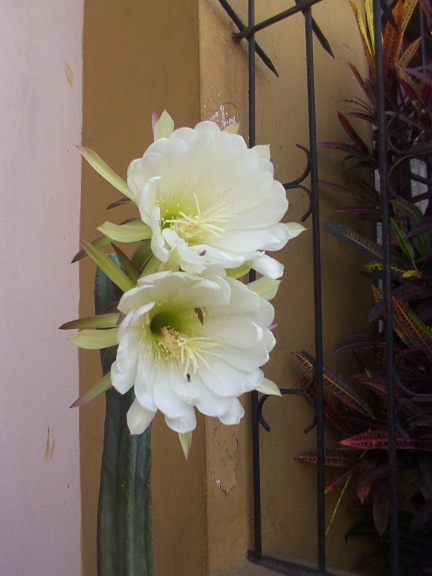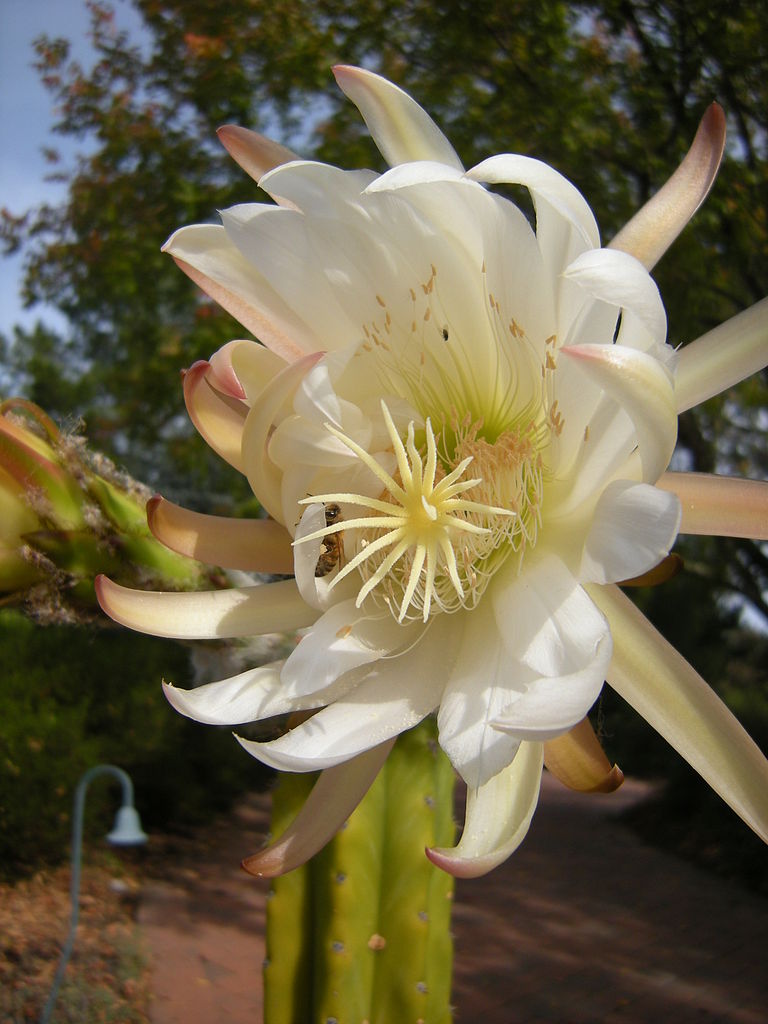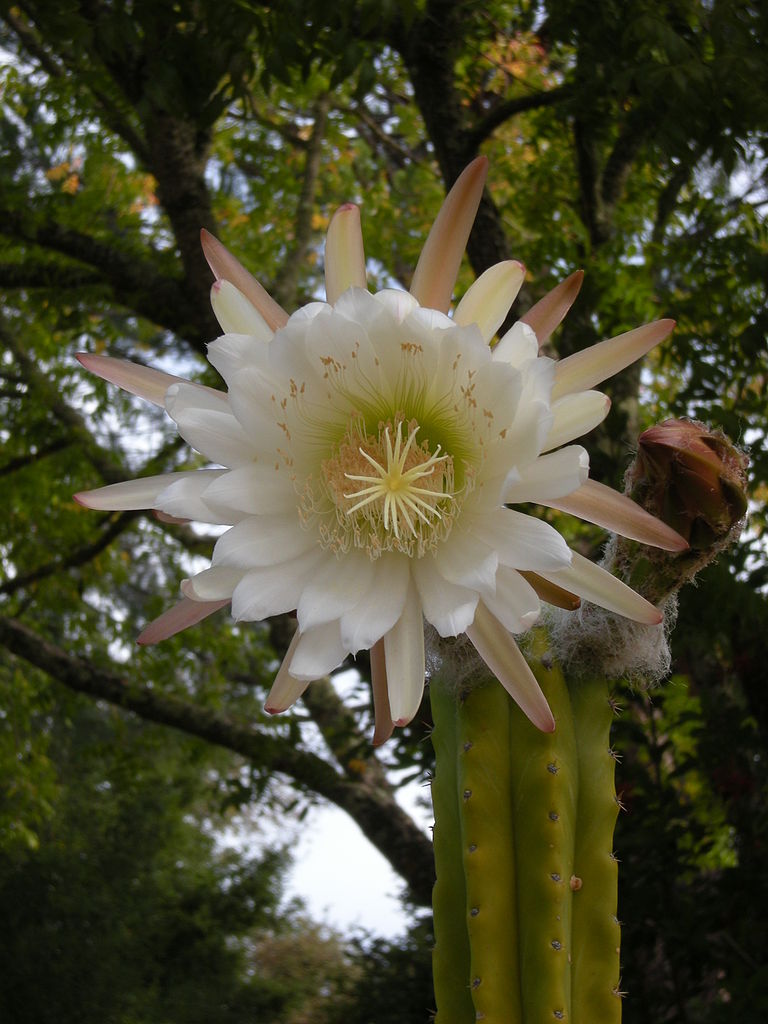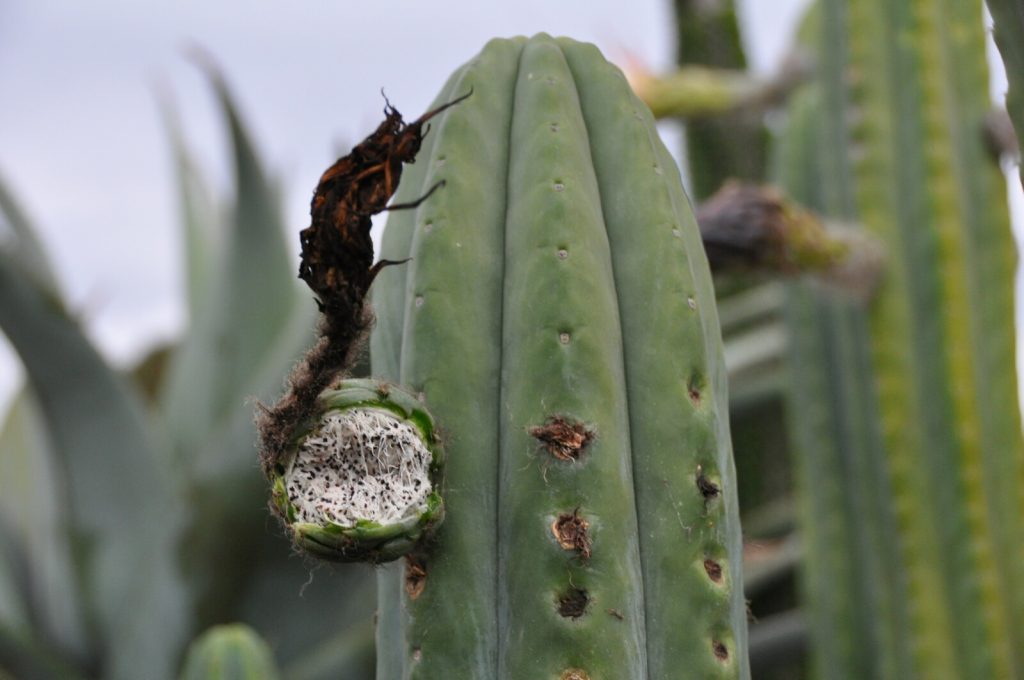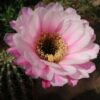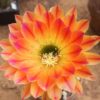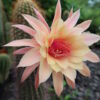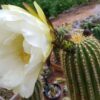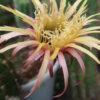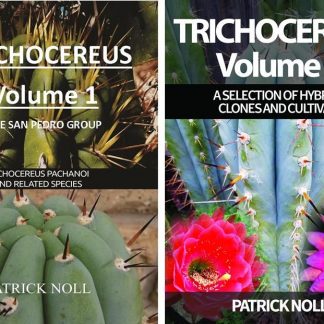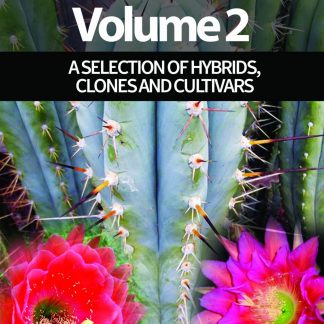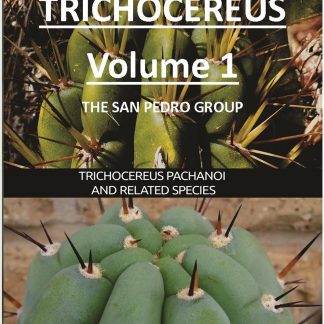
Trichocereus pachanoi, also known as Echinopsis pachanoi, is columnar cactus with a long history of being grown as a crop and ritual plants. Today they can be found in every South American country. It is endemic to Peru and Ecuador, where the type locality can be found.
Please note that this is a purely informational article and we do not sell any plants or seeds of Trichocereus pachanoi.
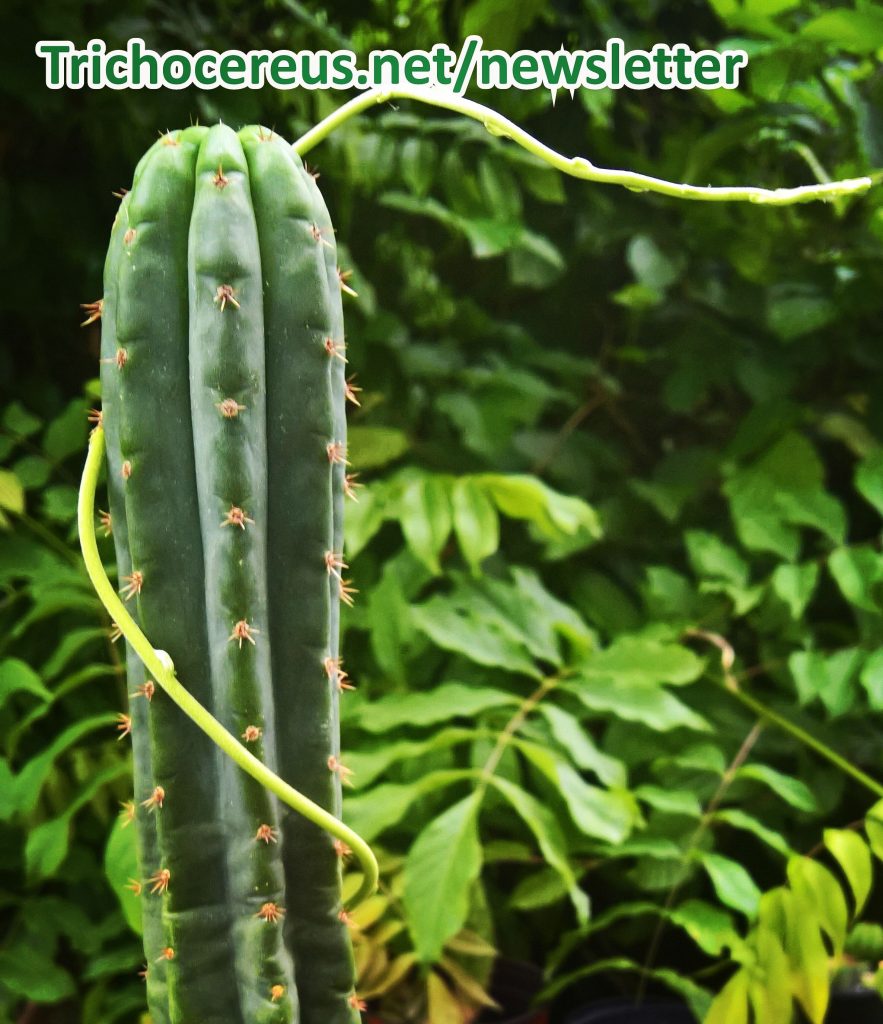
The official and currently valid name is Echinopsis pachanoi, which came up when Friedrich & Rowley made a poorly thought out merger of the genus Trichocereus with Echinopsis! Trichocereus and Echinopsis are closely related, but there are so many differences in regards to the flowers and the body that it makes no sense to use Echinopsis for all kinds of different plants, while the same authors support the differentiation of even closer genera like Loxanthocereus and Borzicactus. I would jokingly call the chaos around the Echinopsis names the dark ages of Trichocereus taxonomy. Now after numerous cladistic studies that pointed out that the genus Echinopsis needs to be changed again, the opinion of many authors have shifted and experts like Joel Lodé went on to use Trichocereus again. The genus Trichocereus is not officially back yet, but it would be highly unlikely if it wouldn´t be brought back within the next 10 or 20 years.
Echinopsis pachanoi aka Trichocereus pachanoi is a VERY variable cactus. It is not easy to differentiate Trichocereus pachanoi from other atypical Trichocereus types, such as a short-spined Trichocereus peruvianus or very spiny specimens of Trichocereus scopulicola. One of the most common strains of Trichocereus scopulicola, FR991, is very similar to Trichocereus pachanoi. It´s actually not really important, but I want to include this interesting little piece of information to point out what other and extremely similar plants can be out there-
Echinopsis pachanoi, aka Trichocereus pachanoi, is a very fast-growing columnar cactus native to the Andean Mountains, where it grows between 2.000 and 3.000 meters altitude.
It´s natural habitat includes Argentina, Bolivia, Chile, Ecuador and Peru but the plant can also be found in countless cactus collections all across the world. It is very similar to its relative Trichocereus peruvianus, now called Echinopsis peruvianus/peruviana or Peruvian Torch. Some growers, including Friedrich Ritter considered them to be synonymous and I tend to agree with that opinion because I’ve seen how extremely variable this whole group of cacti can be. Its general appearance depends on the environment and the overall health of a specimen. Trichocereus pachanoi is a very important plant for the Peruvian natives and has been used for all kinds of purposes.
Traditional names of Trichocereus pachanoi:
Achuma, Wachuma, Aguacolla, Huachuma, Hahuacollay, San Pedro,
Description of T. pachanoi:
Trichocereus Pachanoi naturally occurs in Ecuador and Peru, but can also be found planted all across Peru, because it was considered a sacred plant for the Peruvian natives. Its stems are light to dark green, sometimes glaucous and have a diameter of 5 to 20 cm and usually 5–8 ribs, depending on the size. The white or gray areoles can produce numerous spines, that can get up to 2 cm long or more, depending on the environmental conditions it is grown in. As already mentioned before, the plant can be totally spineless. The areoles are spaced evenly alongside the ribs, and between 1 and 2 centimeters apart.
Trichocereus pachanoi grows like a tree and reaches sizes of up to 6 meters and in some rare cases, even more. The plant pups from the base and grows columnar, unlike the smaller, clumping species of Echinopsis. Trichocereus pachanoi is a textbook example of a columnar cactus. It is one of the most beautiful cacti that are out there. The skin color can vary greatly and while some of the Ecuadorian Trichocereus pachanoi have a bright green color, there are many glaucous types. Most collection plants lack the spines while the specimens in the habitat usually tend to have more spines. There even are forms which are said to be the wild, spiny form of Trichocereus sachanoi and which was probably brought into cultivation by Karel Knize. I once bought some of those “wild Pachanois” and they had very long and yellowish spines.
Flowers: White, coming out at the upper parts of the Columns. Trichocereus pachanoi is a night flowering and self-sterile species. That means it needs another pollen donor to produce seed. The flowers are very large and attractive, usually around 18–25 cm long and with a diameter of up to 21 centimeters. It produces green fruits that are up to 7 cm long.
The flowers produce a very pleasant smell. The sepals have a brownish/reddish color while the petals are white. The stylus has a green base. The tube is covered with gray/black hairs.
Type location: Ecuador, Chan Chan Valley.
In the original description, Rose mentioned that Trichocereus Pachanoi comes from the higher areas of the Andes, where it grows at 2000-3000 meters altitude. Britton and Rose considered Cuena in Ecuador as the location of the type. That means that the plants that can be found there are the most typical for their description. Trichocereus Pachanoi grows all across Ecuador, from the Chan Chan valley down to the large Armatocereus populations in the south. In addition, the plant can also be found all over Peru and those plants are usually wild forms.
Trichocereus Pachanoi was named in honor of the well-known cactus collector and taxonomist, Pachano.
Commercial names and synonyms
Trichocereus sp. Torres & Torres, Trichocereus huanucoensis, Trichocereus, Tom Juul´s Giant (which is probably just an Ecuadorian Pachanoi), TPM, Trichocereus HBG 53196, Loehmans monstrose Trichocereus, Trichocereus OST 90641, KK2150 Trichocereus, and so on.
Cultivation: Trichocereus pachanoi is very easy to cultivate. It’s a plant take can take a fair amount of frost and that´s relatively frost hardy for a cactus. Short night frosts and short temperature spikes down to minus 5° Celsius shouldn’t be a problem for them, but it also depends on the general health of the plant. I do not recommend to leave it in wet soil for long if the temperatures are low. This is one of the plants that takes a lot of water when the temperatures are high. In summer, I water them weekly and fertilize them once a month. And they love it. They need to reach a certain before they will ìflower, but if you give them a large enough pot and sufficient nutrients, they will even flower without free root run. I can recommend a sandy, acidic soil that dries up very fast. That ensures that the plant is dry once you bring it inside to the winter storage. In some warmer countries, Trichocereus sp. can be grown outside and they usually take it very well. I saw beautiful specimens in Australia or California. The Only thing you need to be careful about is rain because they don’t like getting wet feet for a long time. They take it for a couple of days, but it´s best if to give them some rain protection and a covering sail to prevent them from being overgrown by moss and algae. During the growth season, Trichocereus Pachanoi can grow very fast if watered on a regular basis.
Ecuadorian Specimens of Trichocereus pachanoi
Trichocereus pachanoi can be found on all kinds of witches markets in Peru and Ecuador. Ecuadorian Pachanoi tend to have a distinct, bright green color and are among the most sought after Trichos that are. In general, Trichocereus Pachanoi makes a great grafting stock, because of its fast growth and frost hardiness. Below you can find photos of plants that are typical for the Ecuadorian phenotype. The plants are often surprisingly spiny, with rounded ribs and 1-3 longer spines on white felted areoles.
Photos of Ecuadorian T. pachanoi
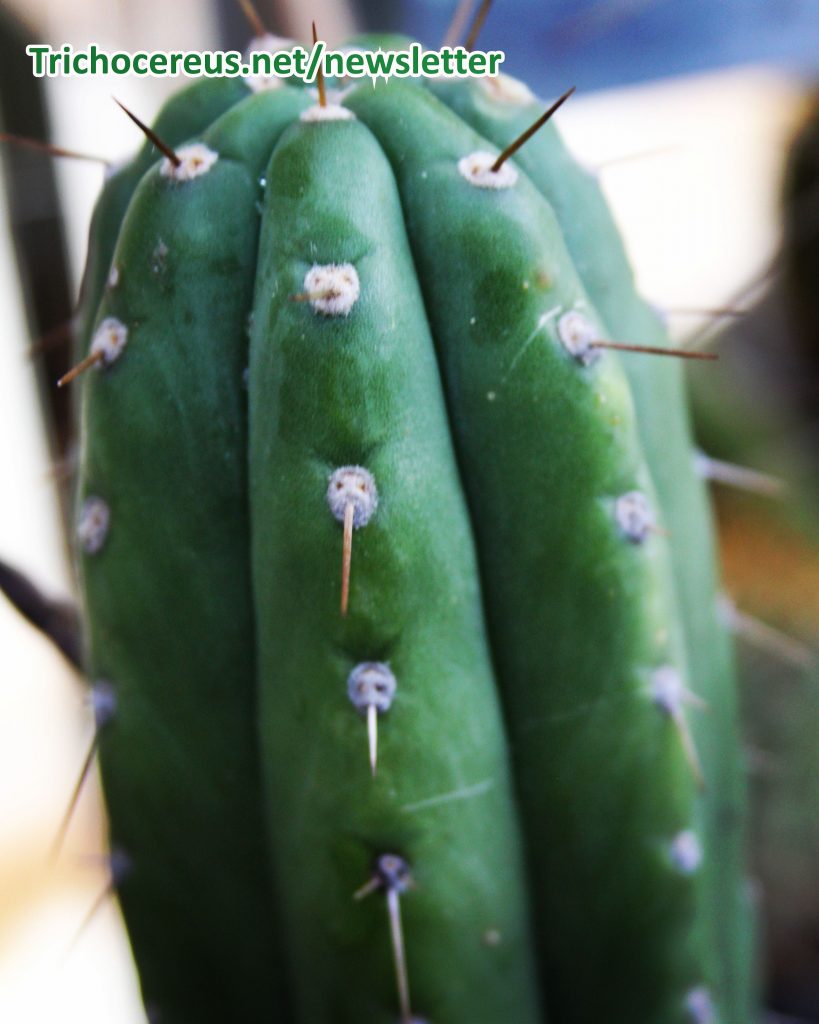
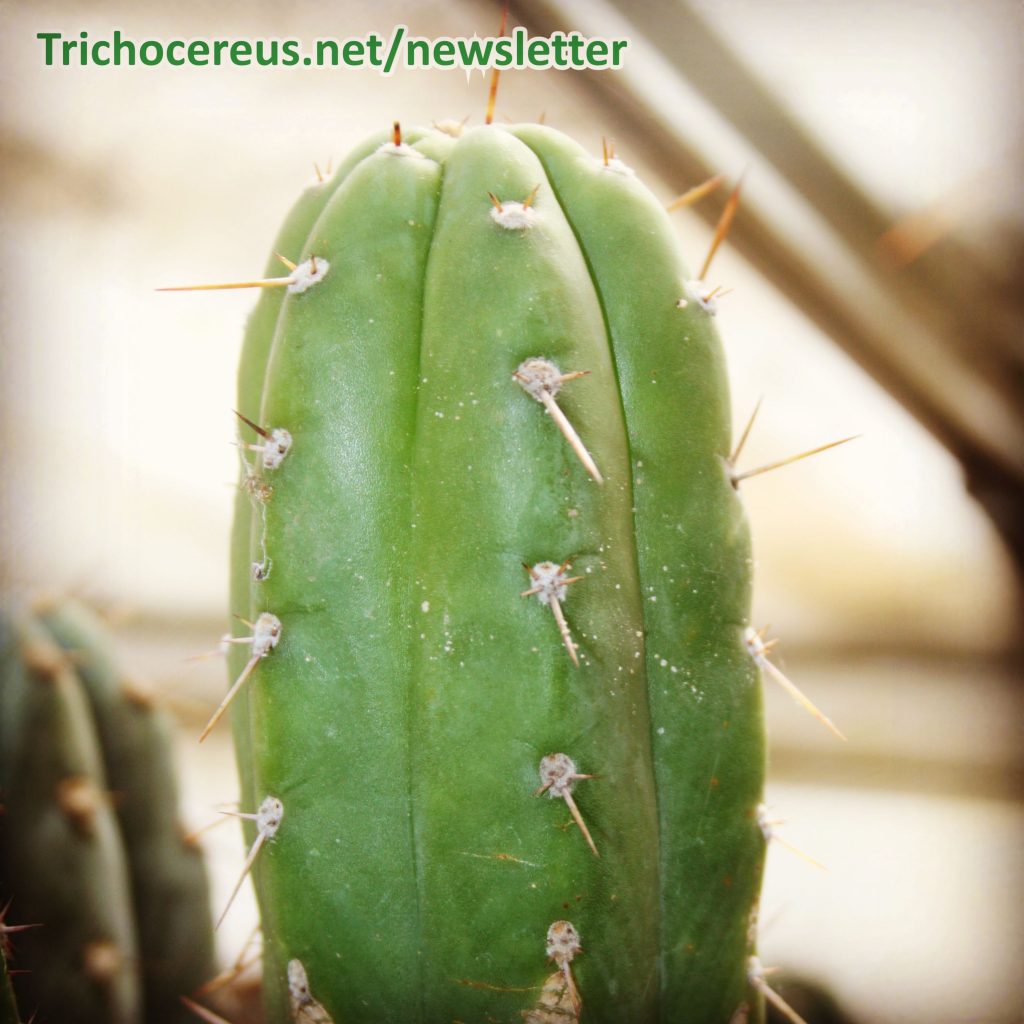
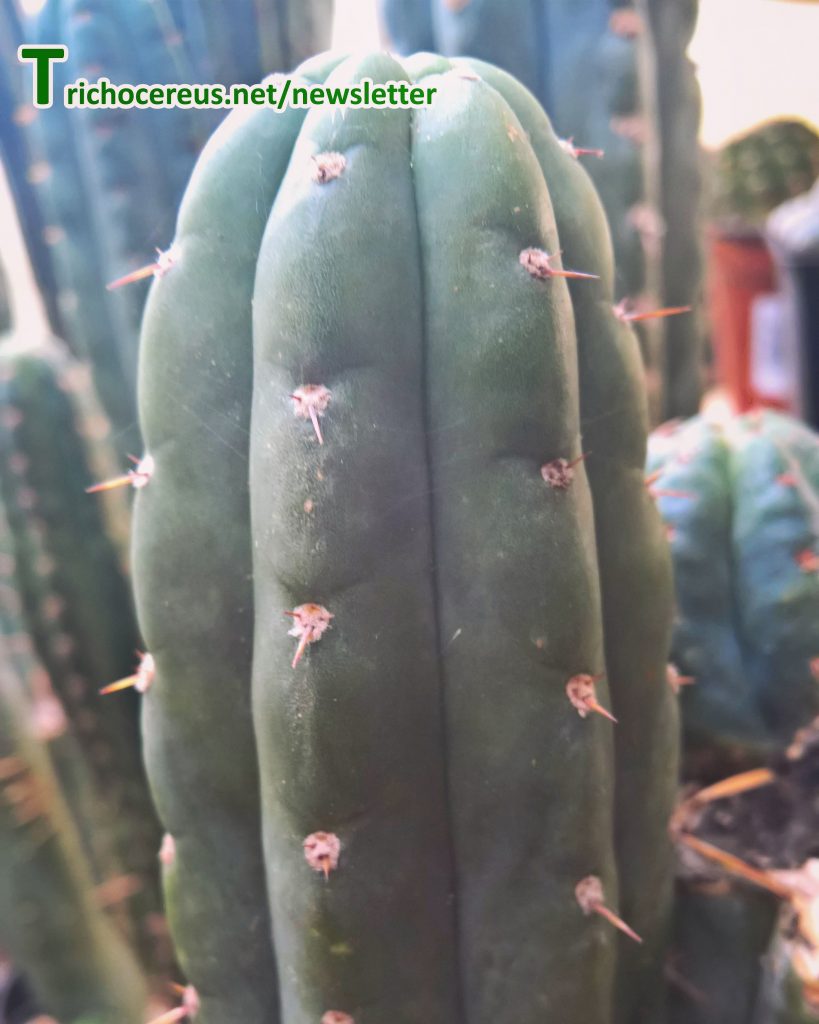
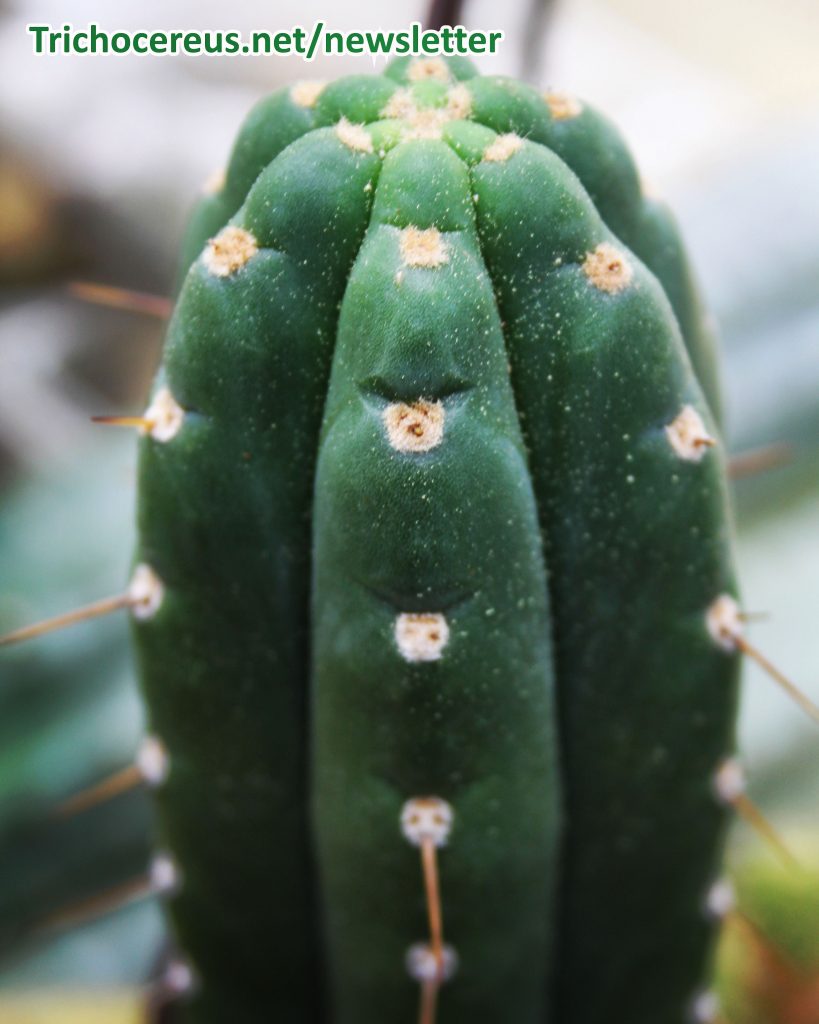
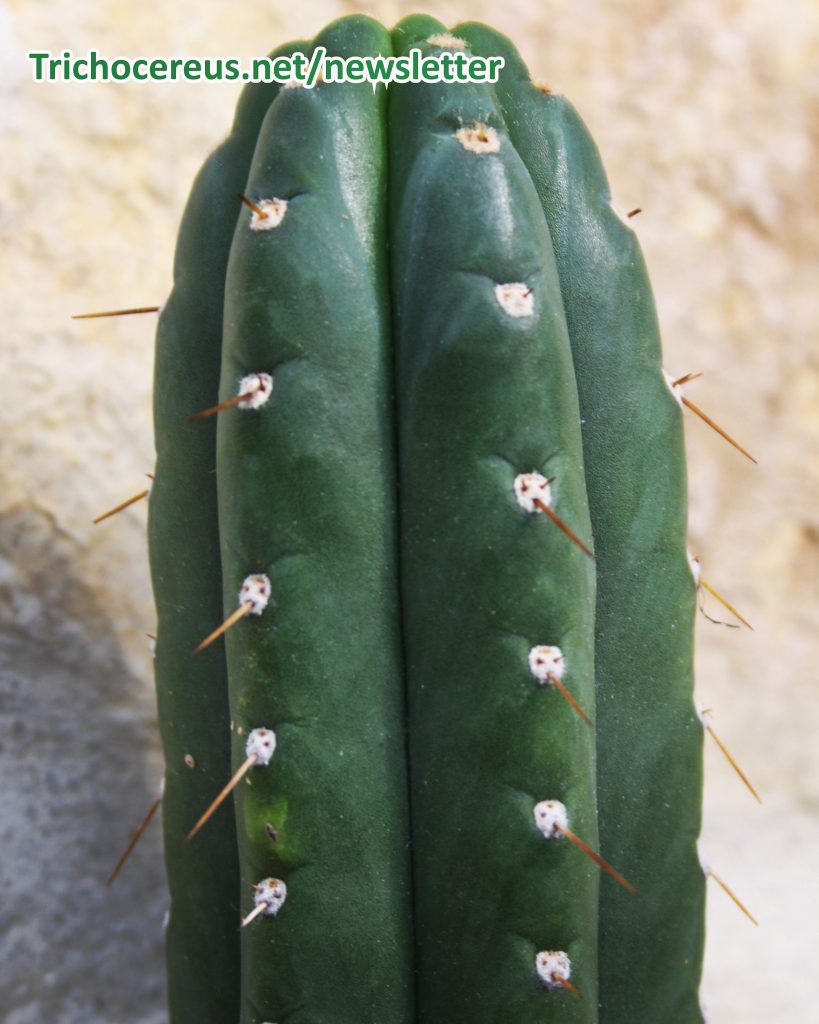
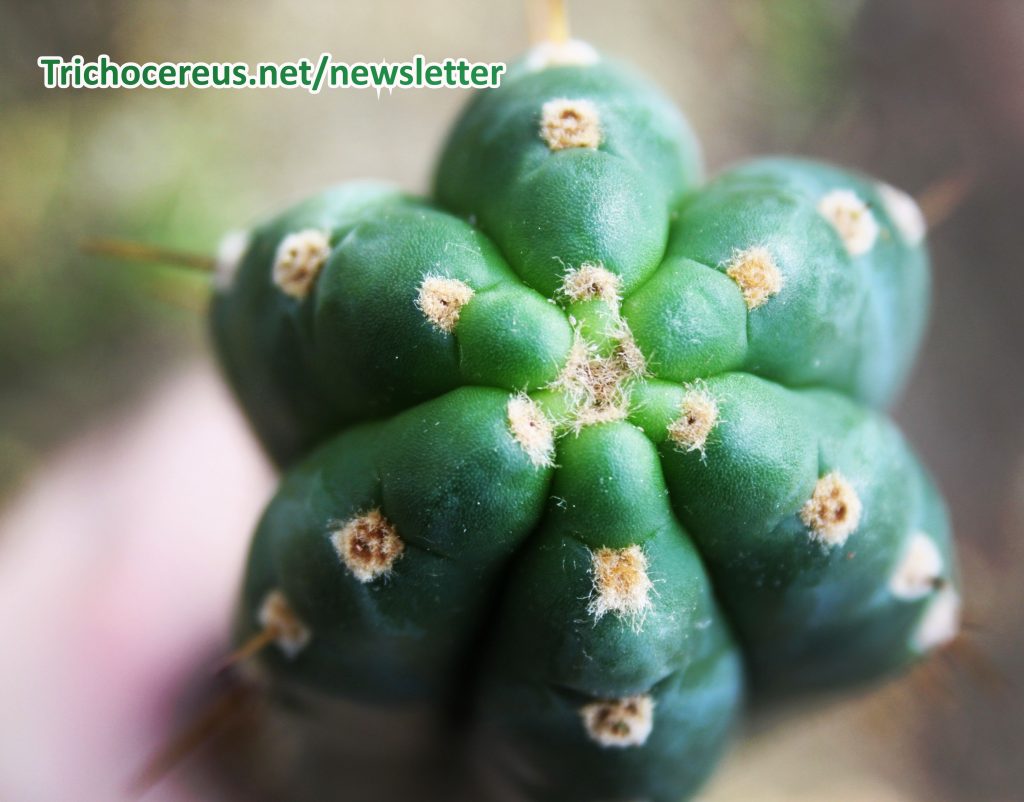
Photos below are from the Sacred Succulents Field Trips and show plants in Vilcabamba Ecuador. Note the dark glow.
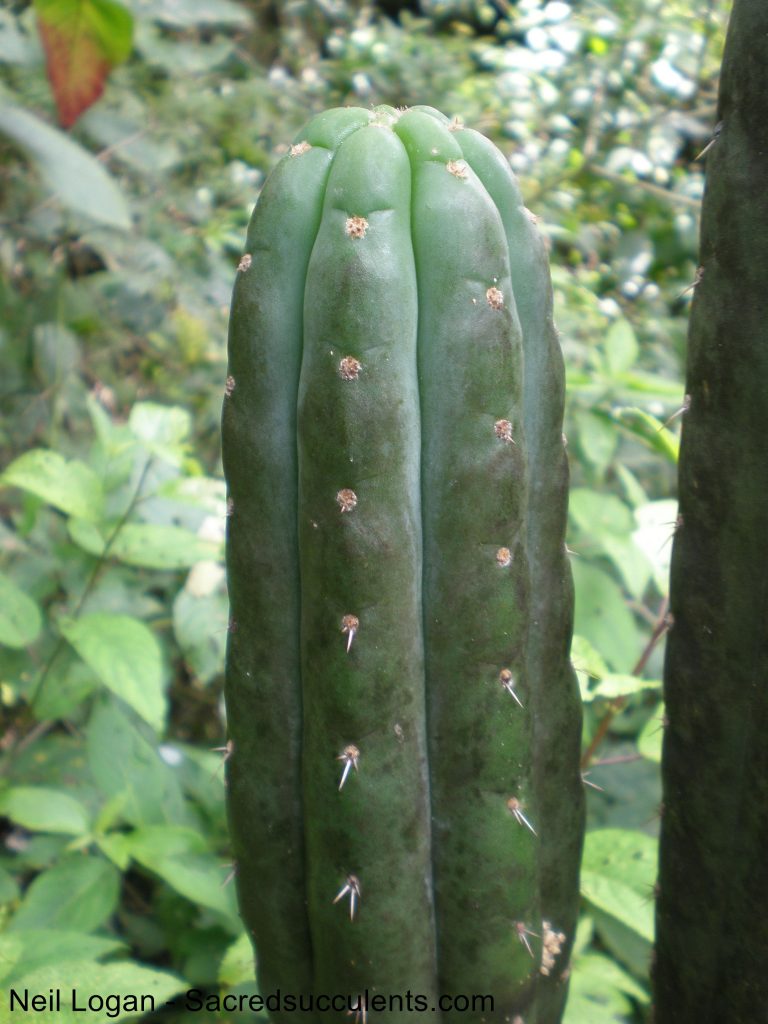
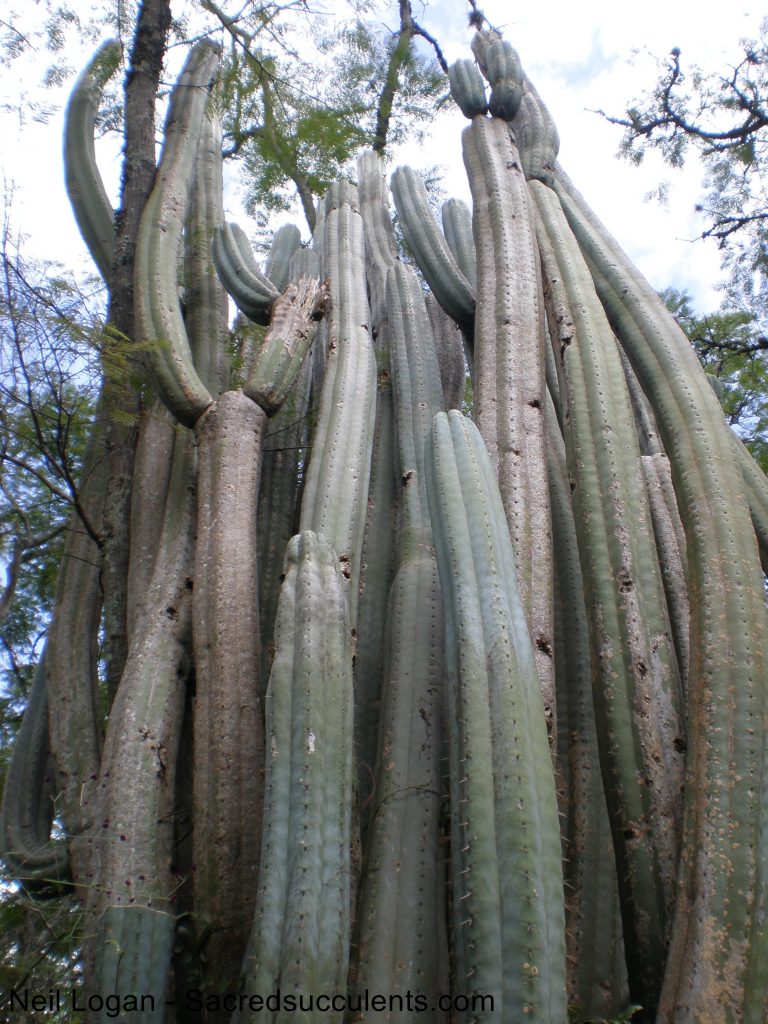
Below Trichocereus pachanoi ‘Zeus’ (Philocacti)
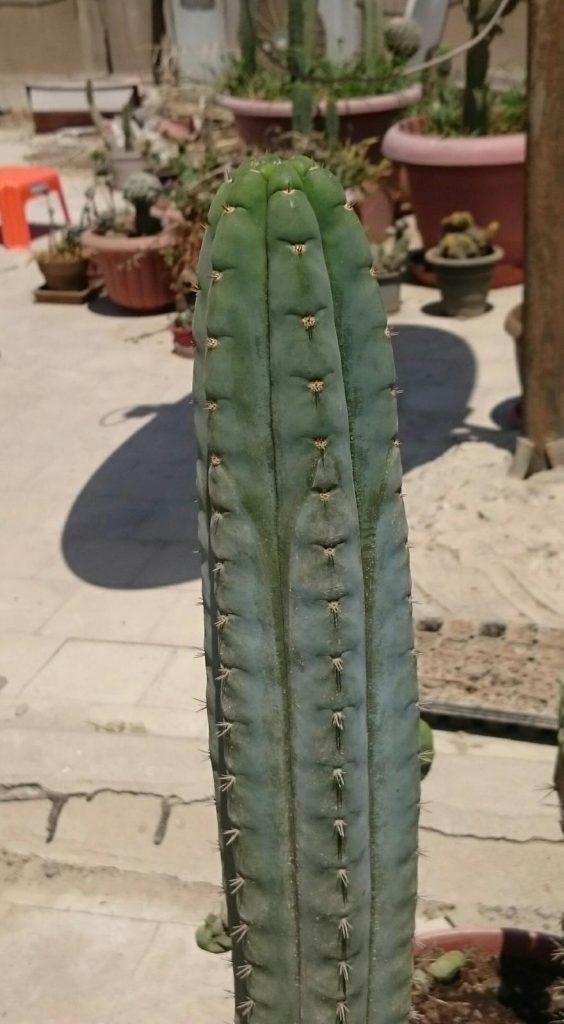
Photo below T.pachanoi KK339 (Rodni Kisar)
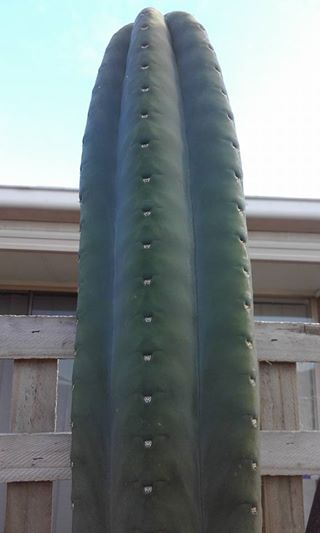
Below: Echinopsis pachanoi photo of KK339 by Karel Knize
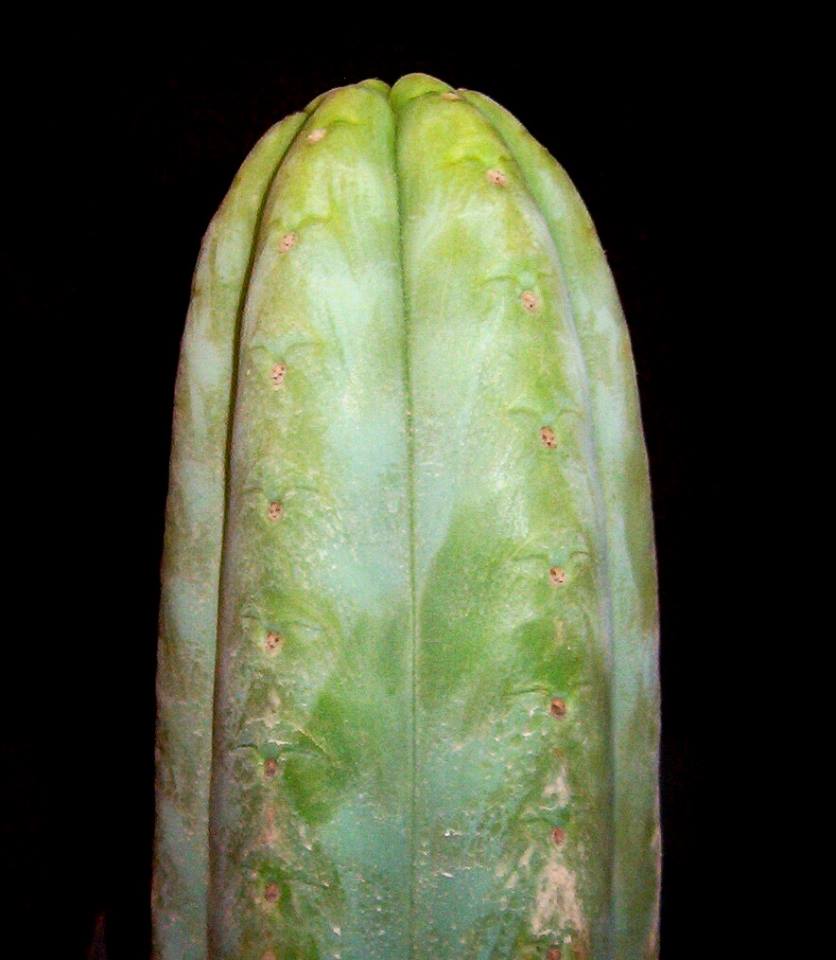
Diseases and how to avoid them
They are fairly resilient and don’t suffer from many diseases. They can suffer from bacterial or fungal rot every now and then and there are various pests & infections that growers can encounter. Black rot is usually benign and heals up after a while. There are fungal infections that can infect all plants from the genus Trichocereus, for example Witches Broom Disease, Damping Off or some other forms of orange rot. In many cases, fungal infections kill the plant within short time and infected plants should be removed from the collection immediately. Another common pest are root mealies, which are often brought into the collection through bought plants from online marketplaces and it’s hard to get rid of them once and for all. Chemical pesticides like Imidacloprid work very well but because they have a very bad impact on the beneficial insects like Bees and worms, I wouldn’t recommend it. Neem or Neem Oil works very well against all kinds of pests, including the hardy spider mites, Root mealies or scale. Scale can also be scrubbed off if the outbreak is not very bad. Trichocereus pachanoi should get a soil without too much humus because it tends to attract rot. Another natural pesticide that is used in organic farming is sulfur, which works against Spider mites and infections. Some growers also like to use diatomaceous earth to get rid of minor pests. Generally speaking, Trichocereus pachanoi is one of the easiest cacti that you can grow and most beginners shouldn’t have a problem to grow them.
Frost tolerance of Echinopsis pachanoi:
Trichocereus pachanoi is able to take short night frosts, down to -9° Celsius, which is 15.8° Fahrenheit. The minimum average temperature is around 10° Celsius or 50° Fahrenheit. Using Valerian flower extract is beneficial and can help to improve their resistance against frost.
General recommendations of things to avoid
A common thing that new growers like to do is taking too many cuttings to get a lot of plants very fast. I really hate because that will slow down the general growth dramatically. Very large plants grow much faster than small cuttings. If you really want to produce a lot of them them (to get grafting stock, for example), make sure not to cut too small segments. The minimum length should be at least 30 centimeters long. That ensures that your cutting is growing fast and vigorously. Cutting a Trichocereus promotes pupping; but only if you don’t cut away too much. Small stumps will often struggle to survive if they werent in a great general shape when the cut was taken and it´s just something that I see a lot. Don´t mess too much with the pH level of the soil, because it can kill the plant if the pH is too high or low. They usually like slightly acidic soil. Don´t use regular plant soil because it contains WAY too much Humus or wood products for them. They might like it in summer but as soon as the temps drop, your plant might rot away because the roots take forever to dry. Don´t leave water standing in the pot because it will spoil the roots. Don´t spray them with oil and leave them in the sun directly after the treatment, because the sun will probably burn it. Only apply oil or alcohol in the evening when the sun cannot burn the plant and make sure not to directly expose plants that spent the winter in the house to the burning sun, because it will give it a sunburn.
Getting Trichocereus over the Winter: Most Trichocereus species can be overwintered in a bright place with a temperature between 10° Celsius/50° Fahrenheit. As long as the plants are in winter storage, they don’t require water because they go into dormancy. Because of that, they should be kept completely dry between October and April. Otherwise, the soil might spoil, what often leads to the death of the plant. Please note that this only applies to growers in Europe or similar country, where the strong night frosts and rain periods would kill the plants outside. Make sure to give them enough fresh air to reduce the risk of fungal infection. Most Trichocereus tolerate cold winter storage very well. Besides, this cold storage is the same that happens to them in nature and it increases their general ability to flower. Plants that are kept too warm all year round have trouble to produce flowers.
Just like the other plants from the genus Echinopsis, Trichocereus pachanoi is very easy from seed. But only if you know what you´re doing. I can recommend the takeaway-tech, which is a development of the Fleischer Tec. Mr. Fleischer was a cactus enthusiast that invented a technique in which he germinated cactus seeds in small glass jars with a closed lid. Now, there are those 250 ml Salad containers that can be used in a similar way and they work with many cacti. Now, the seeds need light to germinate. So you don´t cover the seeds with soil but sprinkle them on the soil. The seeds of Trichocereus Pachanoi are very tiny. As a soil, I can recommend a mix of standard sowing soil (not regular plant soil because sowing soil does not spoil so easily) and sharp coarse sand. This way, the chances for fungal infections are rather slim. In addition, you can add a fungicide right when you add the seeds. There are various fungicides available on the market. Just make sure to not use Sulfur or copper during the germination process. Sulfur works great to get rid of infections on adult plants; but it can kill every single seed in a sowing container. So don´t use it if you intend to germinate seed. You can ask your pharmacist about potential fungicides.
Now, after you mixed the soil, you put it in the small see-through container and make sure to even out the soil layer by slightly stomping the soil with another growing container. This is to avoid that the seeds fall into little cracks. The soil level needs to be straight to ensure that the seedlings have enough stability later on. After you consolidated the soil, you can sprinkle the Trichocereus seeds on top of the soil. Then, you get yourself a water sprayer, add in some fungicide or antibiotic solution (but only one that doesn’t kill seeds) and spray the whole thing very lightly. Trichocereus Seed does not take a lot of water to germinate. Make sure not to add too much water, because it WILL 100% kill them if the soil looks like a swamp. Besides, make sure to get yourself VIABLE seeds. There are many crappy seeds available on the market and many of them are not viable anymore. Trichocereus seed usually stays fresh for 5-10 years, but the germination rates are best during the first year. After you’ve sprayed the whole seed/soil mix, you can close the lid and take it to a bright spot, like a window or under an LED lamp. Light increases germination rates dramatically and I can only recommend you to get yourself an LED lamp. But I’d recommend you to get one that uses High Power LEDs and that has at least 150 Watt. From all the things I got myself, this was the thing that increased the germination rates the most. Don´t bake the seeds though; a light spot on the window is absolutely sufficient. Ideal germination temperature is between 25 and 30 degree Celsius. If the seed was viable, you will get some germinations within 2-3 weeks. If you get white mold on the seeds, they are probably dead. It does not help to leave seed wet for more than 6 weeks in order to “wait for germinations”. It’s rather counterproductive so if you don’t get germinations within 4-6 weeks, take off the lid, let everything dry out and then, restart again. Difficult or half-dead seed can be treated with Gibberellic acid to wake it up from dormancy. Besides, cycles of drying out and watering can help to bring back zombie seed to life.
If you get mold inside the container, take off the lid asap and water away the mold. At this point, you´ll have to leave the lid open and grow them without a lid. If you do that, they need to be sprayed with water on a regular basis to stay alive. Like, twice a day. But don’t keep them wet for long and ensure that the soil can get dry between the watering cycles. Otherwise, you might get fungus gnats, which look like tiny, see-through worms. In that case, let the soil dry out.
The small seedlings have enough nutrients to survive for a couple months, but it helps to fertilize them IN A VERY DILUTED CONCENTRATION every now and then. Don’t use the regular dose that adult plants get or they will die. Besides, don’t expose the seedlings to DIRECT sunlight or they will get sunburn and die. Well yeah, after one year, they should be big enough to re-pot them and single them out. If you encounter problems in your culture, just let me know and I´ll try to help you!
The flowers of Trichocereus pachanoi:
The flowers are large, white, hairy and covered with scales. The color of the hairs is usually black or brown, while the color of the hair on the buds or flowers on the PC clone is mostly white and similar to that of Bolivian species like Trichocereus bridgesii.
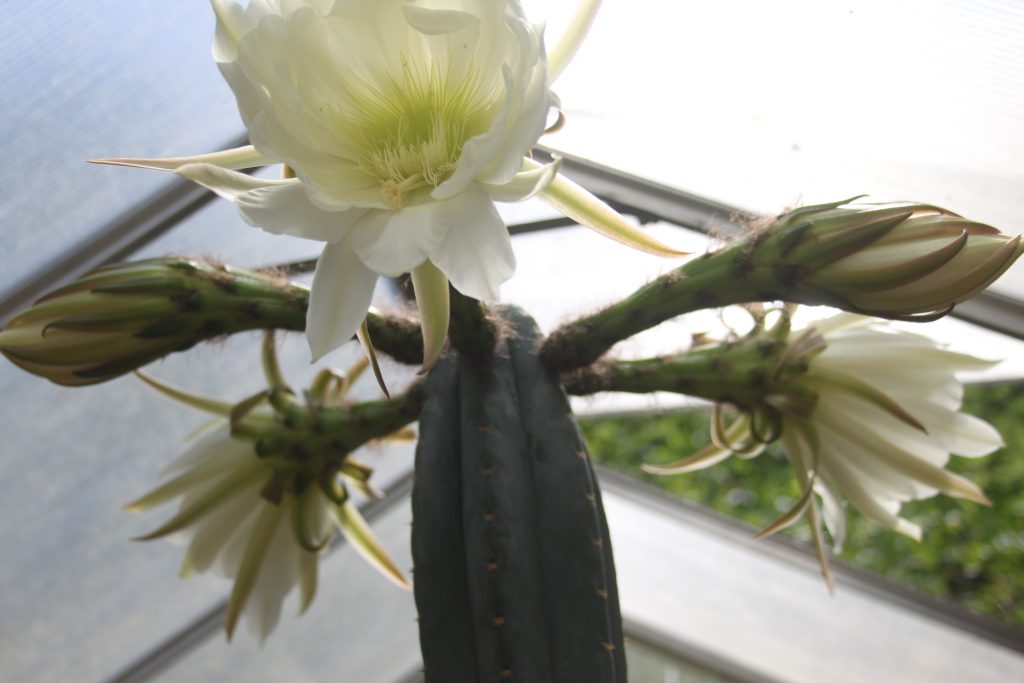
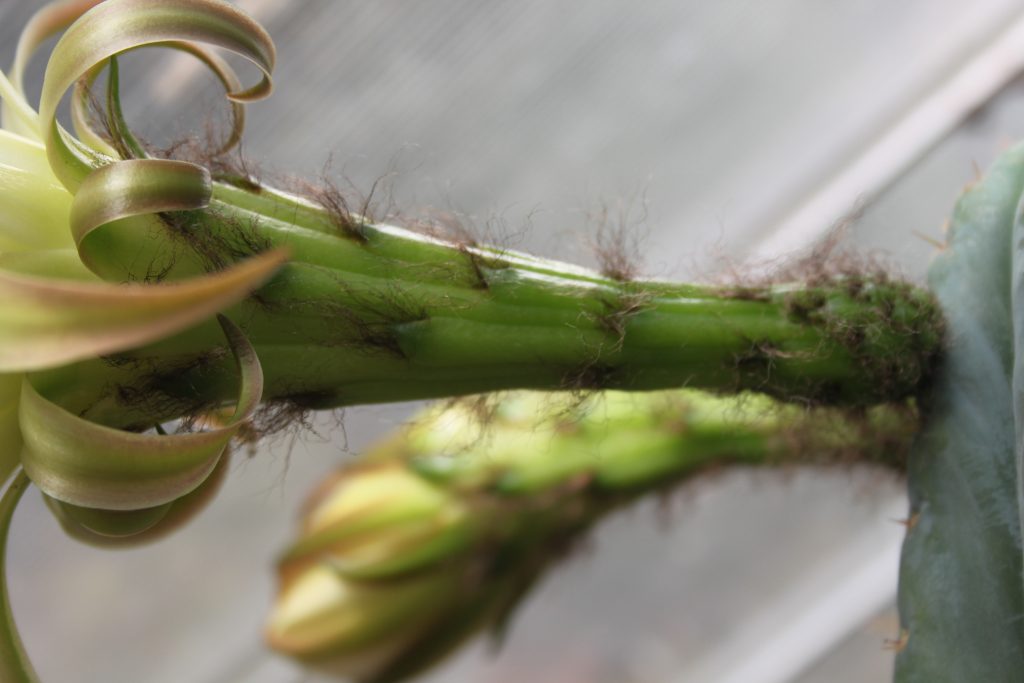
Photos of T. pachanoi
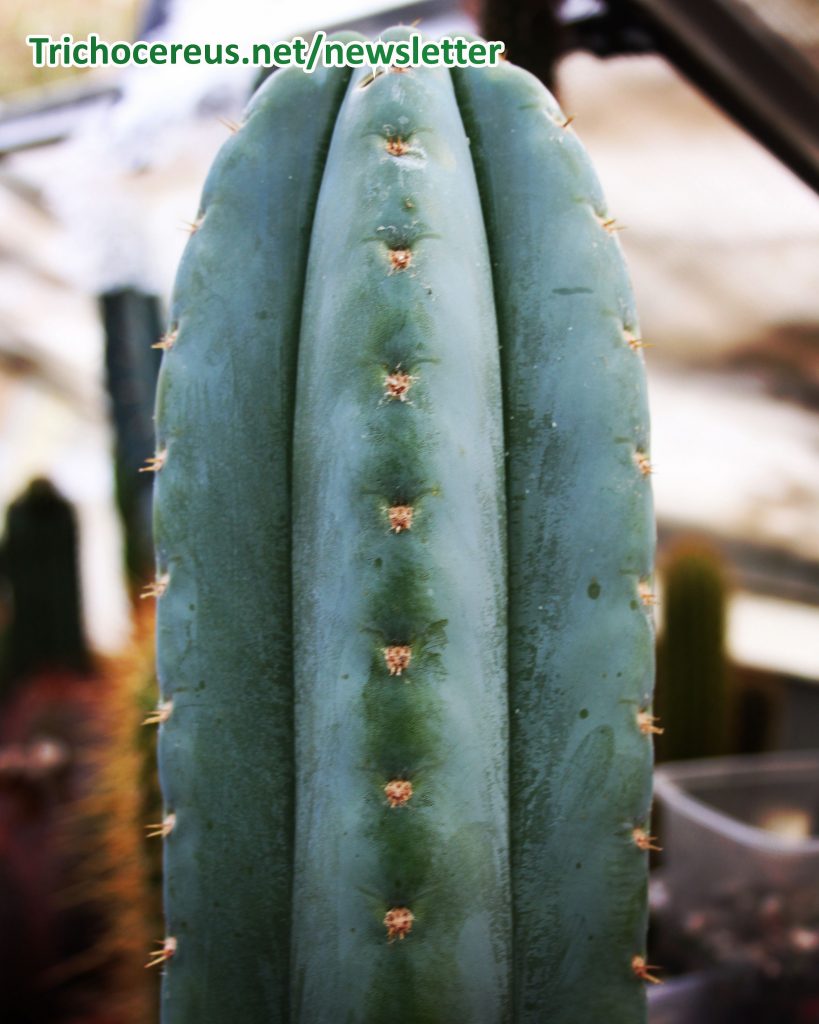
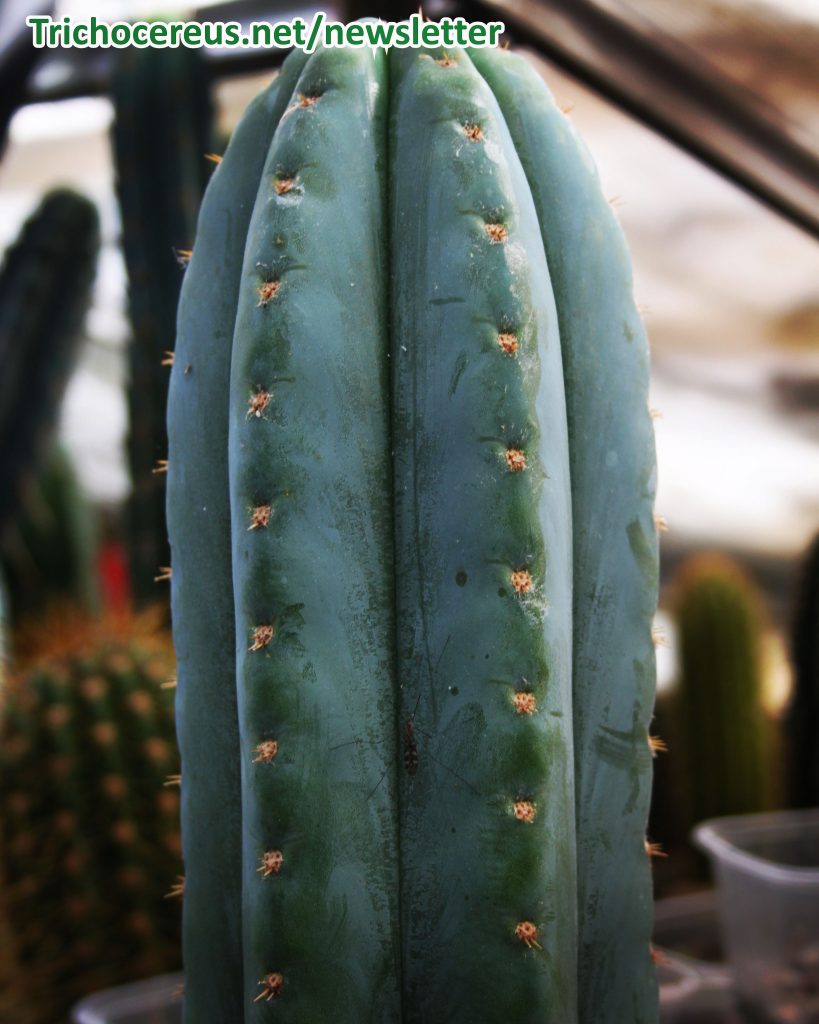
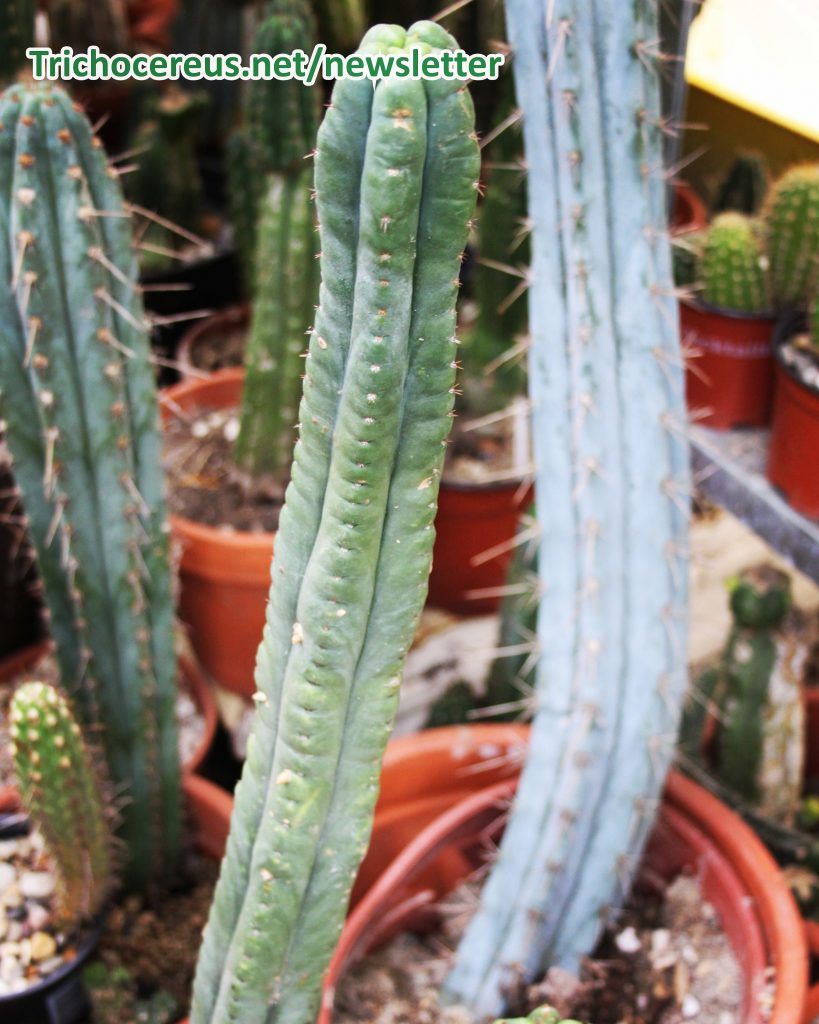
A typical specimen with relatively short spines.
Another very beautiful strain. The spine length is around 2 cm and this is not very uncommon.
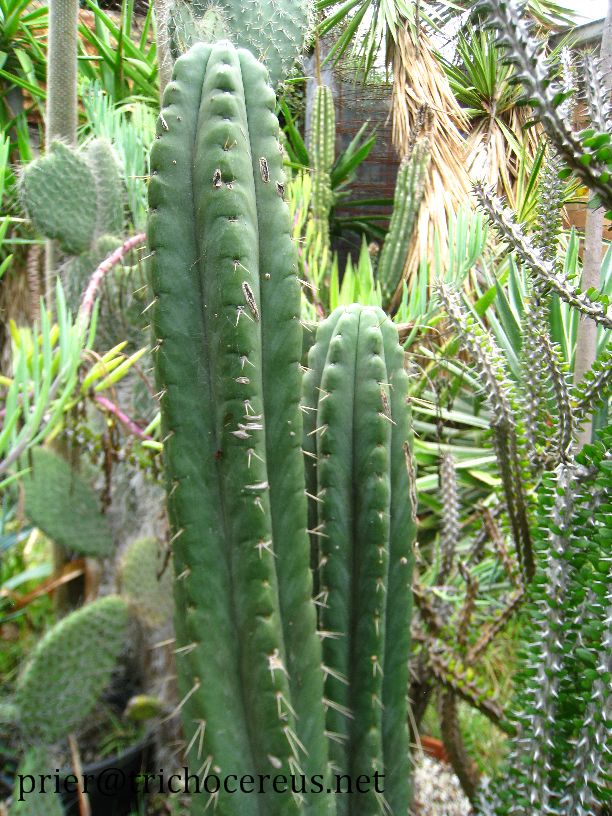
Trichocereus pachanoi ‘Yowie’
Rather spine specimen, which might actually be an intermediate between T. peruvianus and T. pachanoi
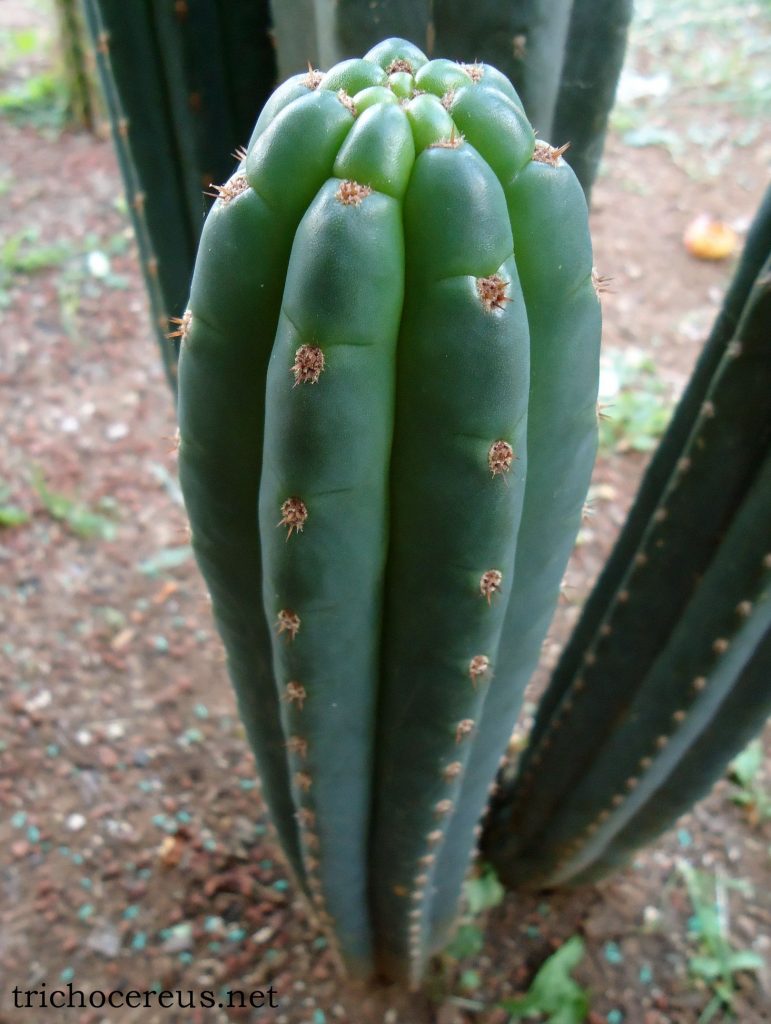
Trichocereus pachanoi ‘Rod’
This picture shows one of the plants that Curt Backeberg sold, also known as Backeberg Pachanoi. He used to recommend the plant for grafting in the 50s and sold huge amounts of em through his cactus nursery.
Trichocereus pachanoi Kimnach et. al. 28760 – Huntington Botanical Garden –
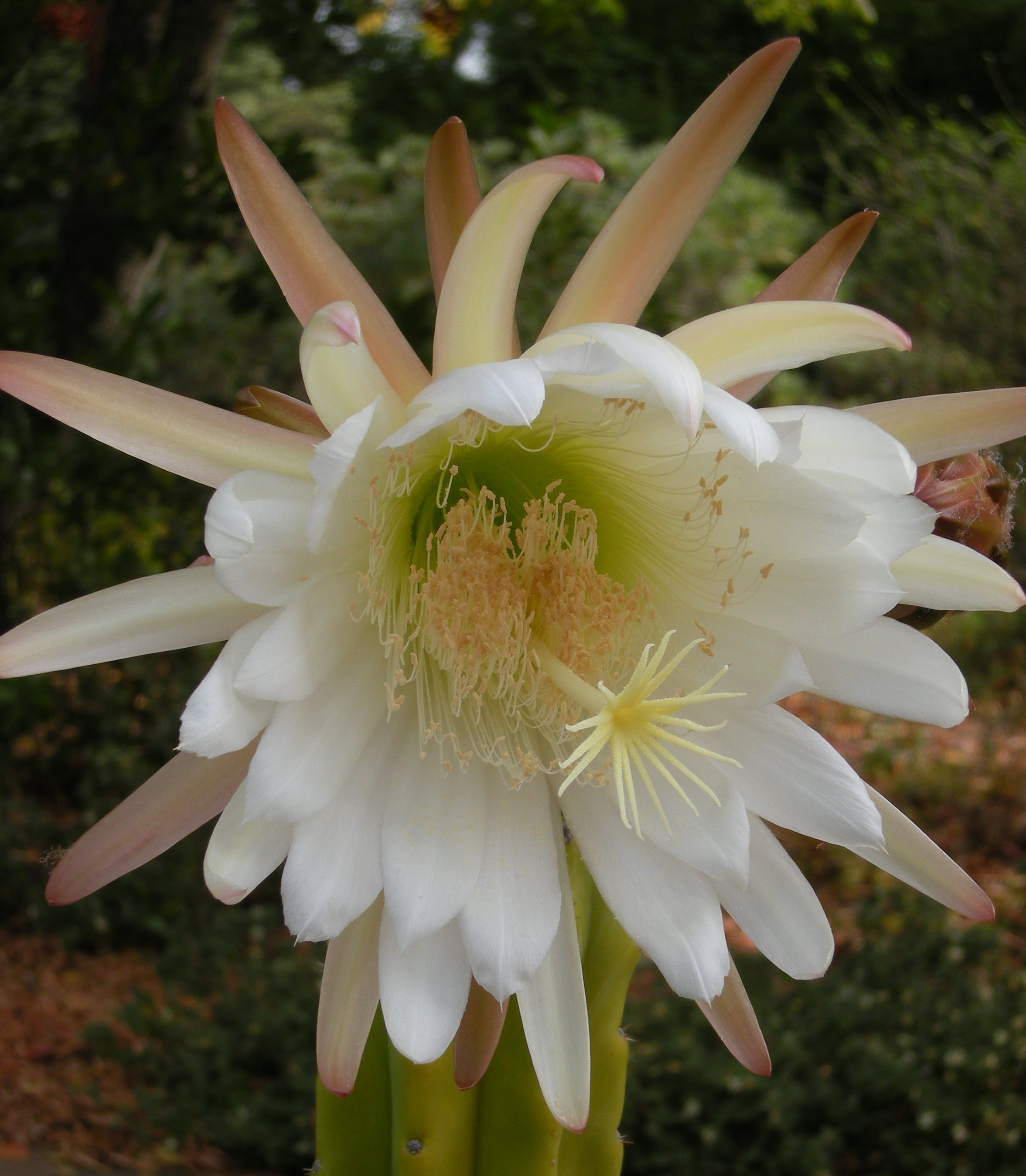
This photo might actually show the PC clone, a version that is often attributed to T. pachanoi, but which needs investigation. Photo: by Lars
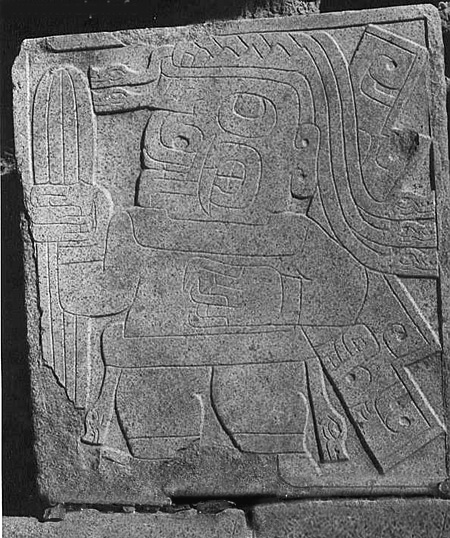
Stone plate from Chavin de Huantar showing typical Trichocereus cacti

Nephiliskos Kaktus-Azteke
Ajor933 _san_pedro
Trichocereus pachanoi PC Echinopsis Predominant Cultivar Predominate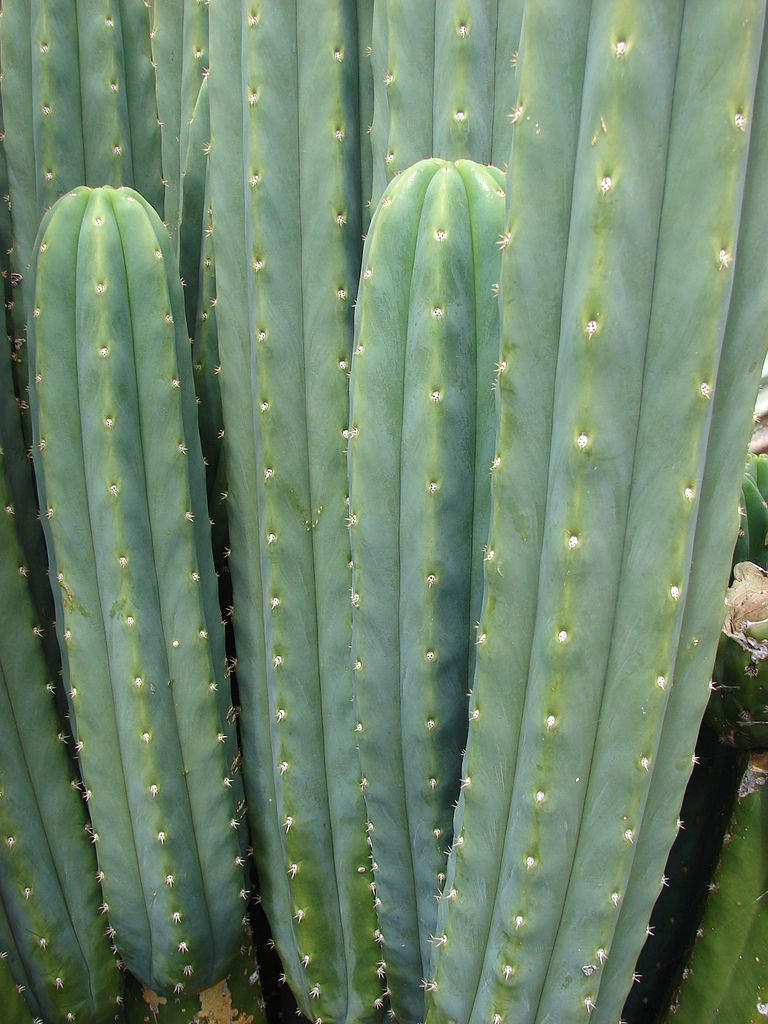
Forest & Kim Starr – Predominant Cultivar, also known as Predominate Cultivar. This one might not even be a Trichocereus pachanoi.
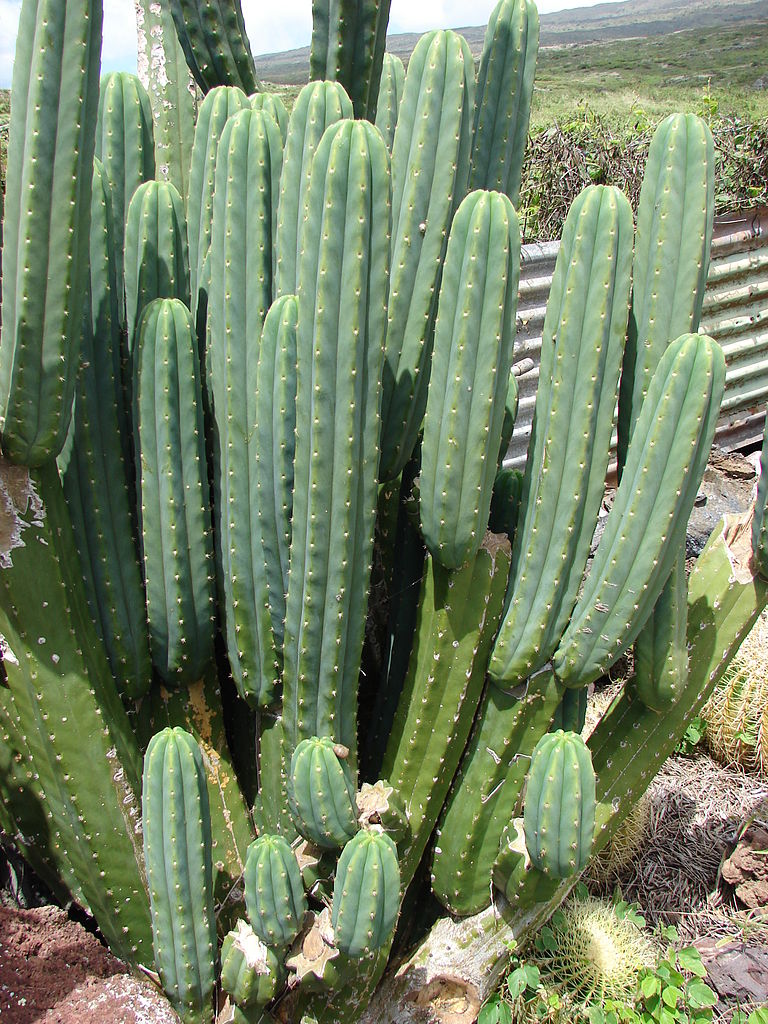
Forest & Kim Starr – Predominant Cultivar, also known as Predominate Cultivar. This one might not even be a Trichocereus pachanoi.
Forest & Kim Starr – Predominant Cultivar, also known as Predominate Cultivar.
by Enfo Jardins_Mossèn_Costa_i_Llobera

Anne Besnier Zavaleta Fleur_de_cierge_du_PérouMacAllenBrothers Echinopsis-pachanoi-peru
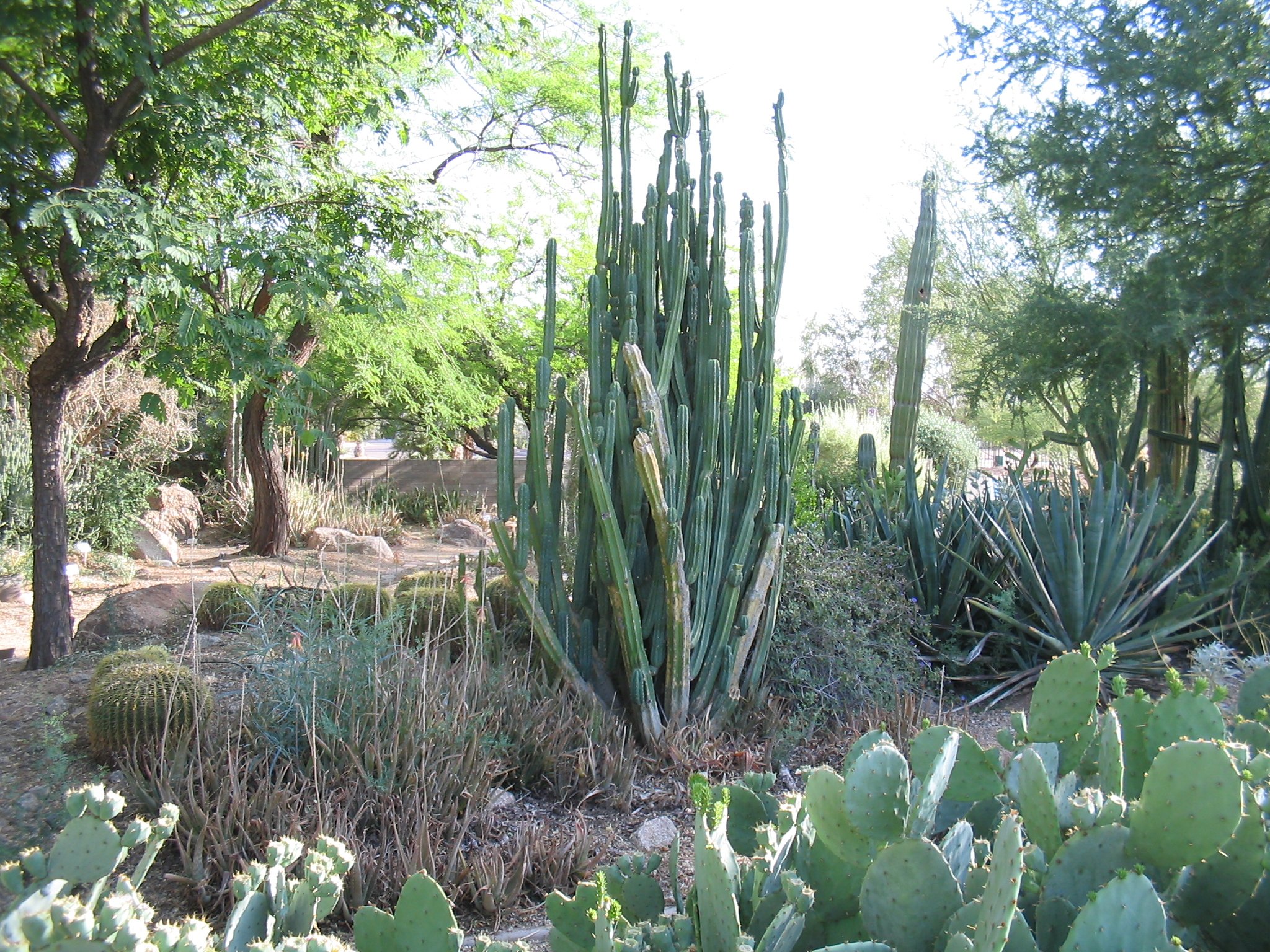
Echinopsis-pachanoi
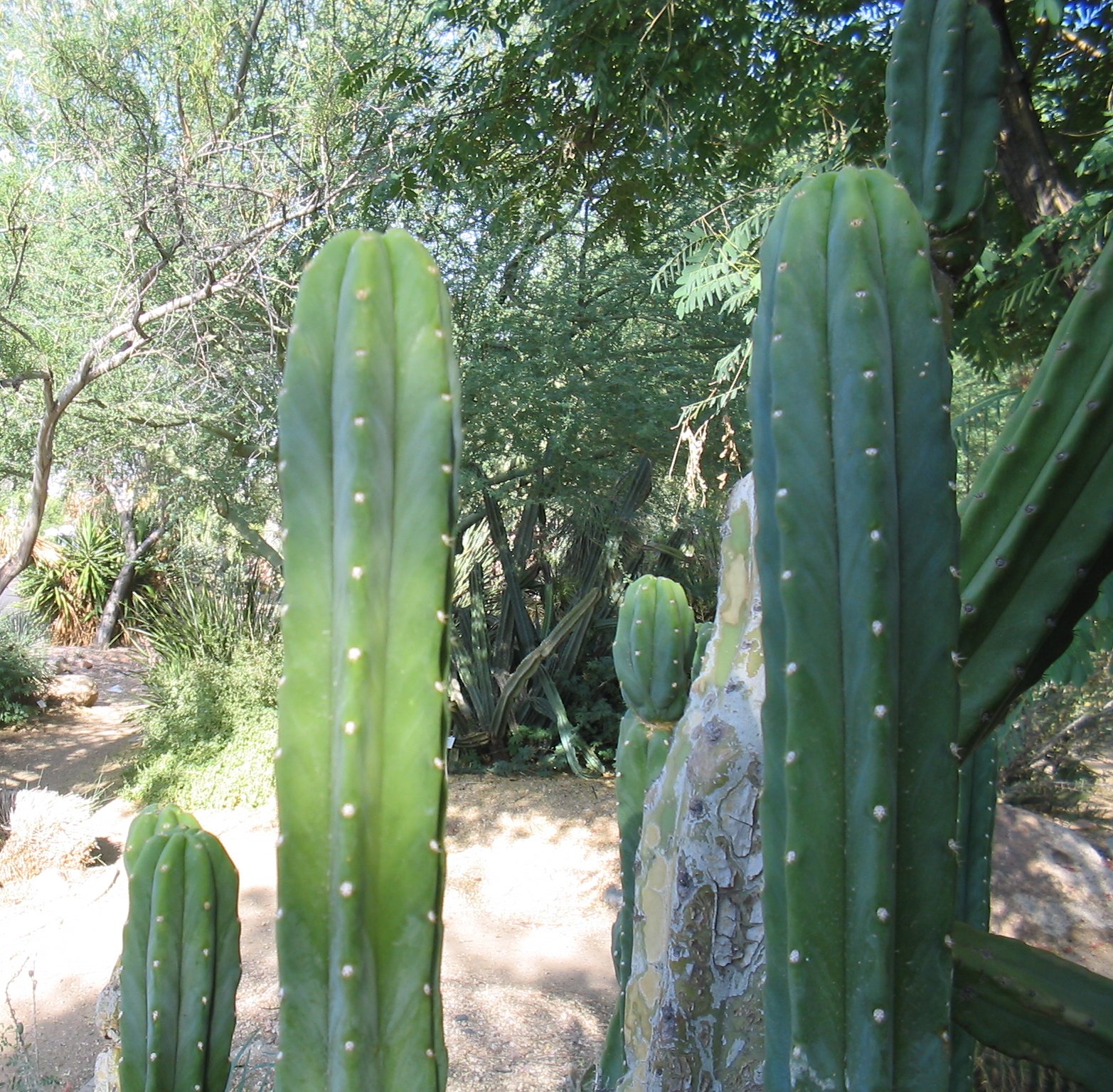
Photo below probably shows the PC clone
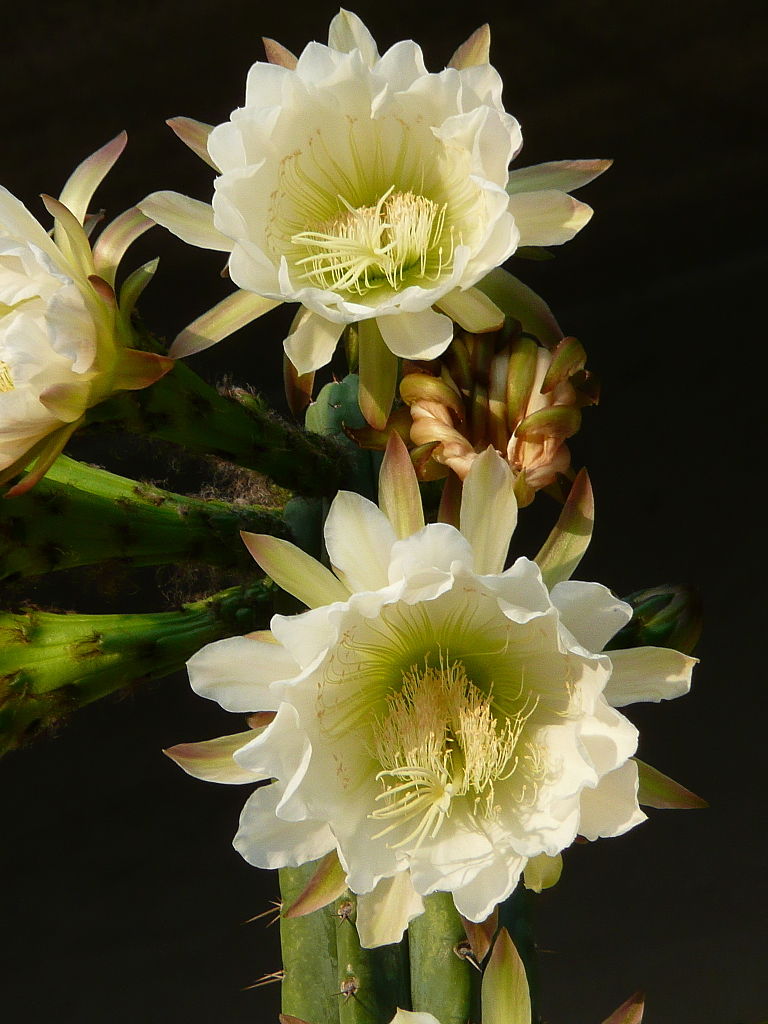
pizzodisevo Echinopsis_pachanoi
by Lars
And now, as a comparison, the almost identical Tom Juul´s Giant, which is considered to be a form of Trichocereus pachanoi. Copyright Misplant.net:
Video comparison between Trichocereus pachanoi and Trichocereus peruvianus
Differences between Trichocereus pachanoi and Trichocereus bridgesii Video
Trichocereus Facebook Group
You can also find information on all kinds of Trichocereus hybrids and species in this Facebook group: Facebook.com/groups/trichocereus
Check out other interesting articles here:

